
WINTER / 2022 THE MAGAZINE FOR THE UK NUCLEAR INDUSTRY Hinkley Point C smashes apprenticeship milestone Driving Digital Transformation Across the Nuclear Industry Building a secure and resilient security infrastructure Britain’s response to the ongoing Russian energy challenge PAGE 4 PAGE 22 PAGE 8 PAGE 2
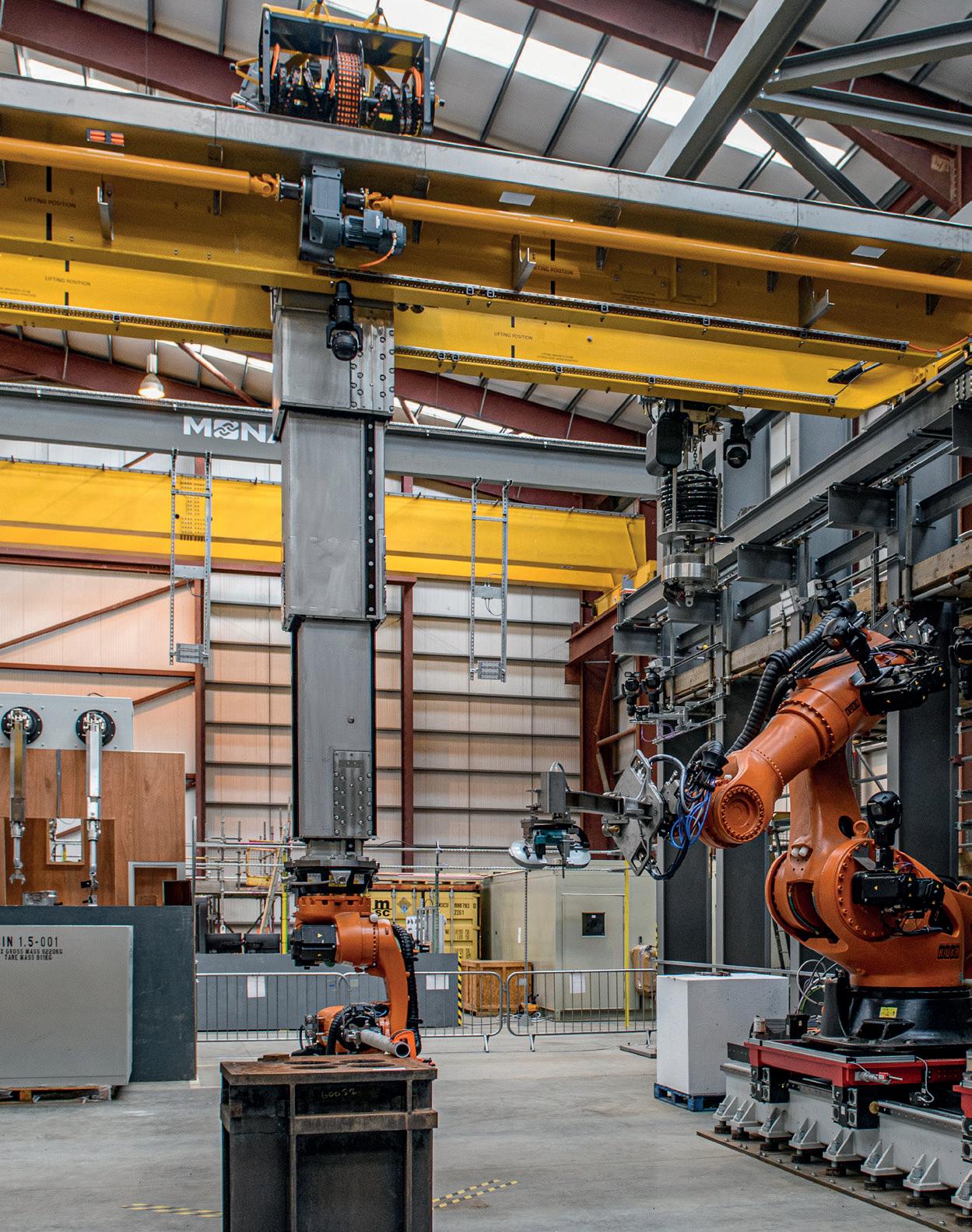
Welcome to the final 2022 edition of Industry Link! Where do I start? It’s been a year like no other in the world of energy, with its price and availability becoming dominant features of our daily lives, in a way they have not been for decades.
What has that meant for nuclear? Well, for starters, there’s been a real shift in public perception. Energy policy has never been so widely reported, so, naturally, the interest in nuclear has heightened as a result. Russia’s energy war, following its invasion of Ukraine, has driven up power prices to levels never seen before. The NIA’s Jake Moorman offers his analysis in these pages.
Governments are also trying to shake Russia’s energy dominance, including in the nuclear fuel cycle. Urenco’s Joe Priestley examines how the UK can do just that and the WNA’s David Hess explains why there’s been a resurgence in nuclear projects across Europe.
2022 has also been a year of industry milestones. STEP unveiled its chosen site for the UK’s first prototype fusion plant; Hinkley Point C’s Freya Lee describes just how important reaching the 1,000 trained apprentices target has been for the project; and Ieuan Williams offers his take what has been one of the most turbulent periods in British political history in his Power Politics column.
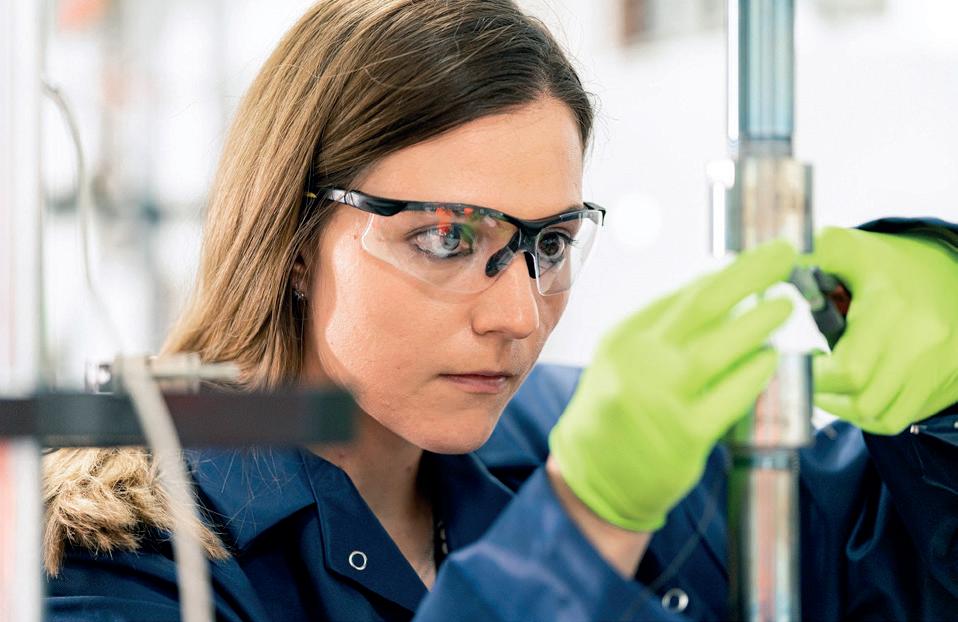
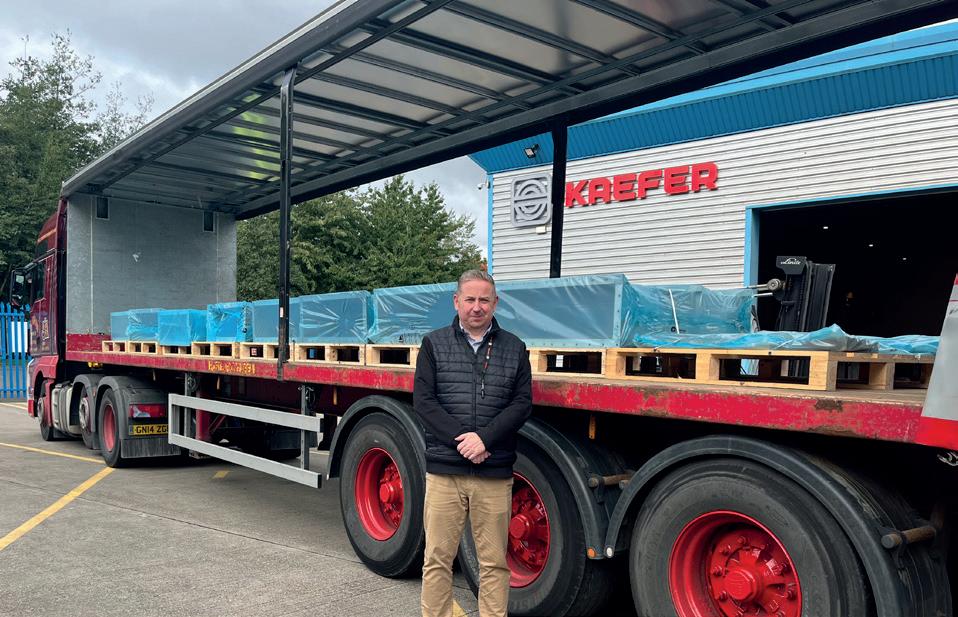
A lot to take in as we head into a new year, but here at the NIA we can’t remember a more exciting time for the industry. Enjoy the read and see you next year!
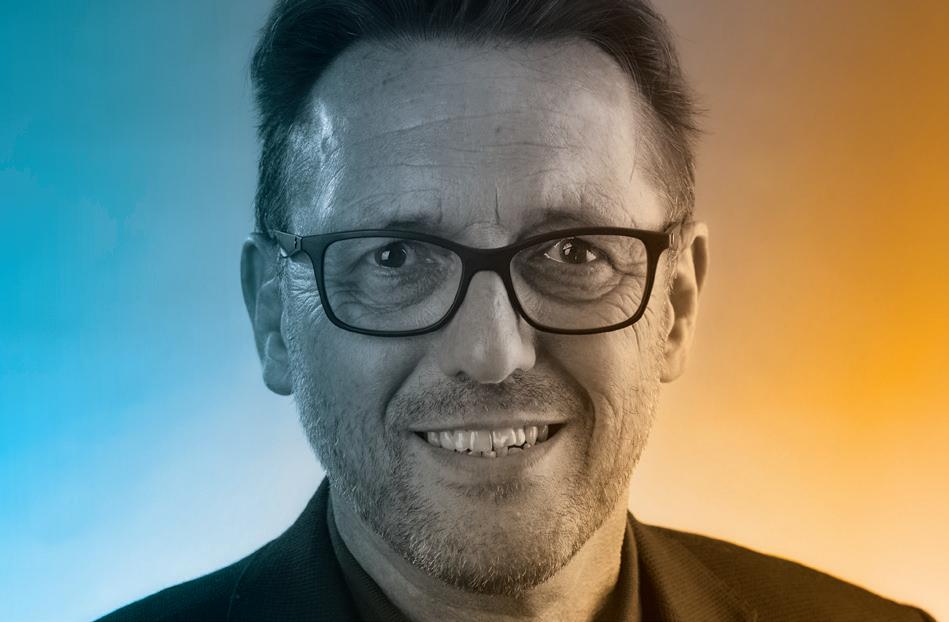
16
WELCOME TO Editor - Iolo James Art Editor - Dan Powney Press & Advertisement Enquiries - press@niauk.org Membership Enquiries - membership@niauk.org Contributors - Ieuan Williams • Georgina Hines • Jake Moorman • Joe Priestly, Urenco • Freya Lee, EDF • Paul Jenkins, Radiocoms • Dave Allen, Nick Deavin, Helen Gladwinfield, Suzanne Owen & Chris Parry, AWE • John Hurst, DBD International • Helen Batt, Osprey • Kris Bradshaw, Capula • John McNamara, NDA • David Hess, WNA • with additional thanks to World Nuclear News Nuclear Industry Association is a company limited by guarantee registered in England No. 2804518 Registered Office - 5th Floor, Tower House, 10 Southampton Street, London WC2E 7HA TEL +44(0)20 7766 6640 EMAIL info@niauk.org Cover image - Courtesy of EDF www.edfenergy.com/about/nuclear/power-stations This magazine is printed on 100% post-consumer recycled paper, using vegetable based inks. NEWS FROM THE HUB. 28 IN THIS ISSUE••• PAGE 26 Europe’s Nuclear Awakening PAGE 18 14 PAGE 10 PAGE 24 NDA STAKEHOLDER SUMMT 2022 DELIVERING EXCELLENCE AT AWE THE POWER TO BE SAFE
Iolo
James Head of Communications, Editor
Britain’s response to the ongoing Russian energy challenge
Amid the changing global energy landscape, Joe Priestley, Senior Government Affairs Manager at Urenco, explains the vital role the UK nuclear sector can play in supporting global security of supply in light of the conflict in Ukraine.

The conflict in Ukraine has highlighted the need to move towards greater energy self-sufficiency and low-carbon domestic energy sources. Amid the current energy crisis, it is essential that the UK seeks to maximise energy generation from nuclear energy and other low-emission sources to achieve Net Zero and decarbonisation targets.
Nuclear technology including nuclear reactors, nuclear fuel, enrichment technology, and technical services is increasingly seen as a key geopolitical instrument. This is highlighted within the All-Party Parliamentary Group on Nuclear Energy’s Report, ‘Resisting Russia’s Energy Way’, that highlights how Russia has been very successfully exporting its nuclear technology, with over 36 countries currently dependent on it for both service contracts to maintain their nuclear facilities as well as the fuel to run them. Not only does this provide an important revenue stream for the Russian economy but also ensures geo-political dependency on Russia. Overall, it supplies one third of global uranium enrichment demand.
Many utility companies, though, are now seeking to move their uranium and enrichment services away from Russia. However, this is increasing pressure on non-Russian enrichers to support the build out of capacity for an alternative to the Russian component of the uranium market, including conversion and enrichment capacity.
For the UK and its allies to achieve energy security, investment in critical strategic infrastructure, including expanding nuclear fuel conversion and enrichment capabilities is urgently required. Urenco, an international supplier of enrichment services and fuel cycle products for the civil nuclear industry, has facilities in the UK—including in Capenhurst in Cheshire—and the Netherlands, Germany, the United States, and is considering its enrichment capabilities and policies in response to the potential for interruption to Russian fuel supply. Any buildout of new capacity, though, would require firm commitments from both utility customers and national governments to provide clarity on market demand.



Moreover, with an increased focus on energy security, advanced reactors (AMRs) and small modular reactors (SMRs) hold promise to deliver power with even more efficiency and versatility. A significant challenge facing the development and deployment of these newer reactors is the development of the nuclear supply chain, including nuclear fuel, and in particular advanced fuels for advanced reactors.
The UK government, at the NIA’s annual conference last year, confirmed High Temperature Gas Reactors (HTGRs) as the technology of choice for its AMR Research, Development & Demonstration Programme. In addition to clean, reliable, low-carbon electricity,
2 — WINTER | 2022 JOE PRIESTLEY • SENIOR GOVERNMENT AFFAIRS MANAGER • URENCO
HTGRs also support widespread decarbonisation through the ability to generate high temperature heat that could offer efficient routes to low-carbon hydrogen production, industrial process heat and low-carbon fuels. HTGRs use new types of advanced nuclear fuel and the existing fuel supply chain will, therefore, require significant investment in order to produce these advanced fuels.
Currently, the only source of advanced fuel for a commercial enricher is Russia. The length of time it takes to establish the funding, address regulatory issues, and then construct the necessary fuel cycle infrastructure creates unique challenges to the front-end nuclear fuel supply chain needed to bring advanced reactors to market. Moreover, this capacity will not develop commercially without a sustained customer base and the advanced reactors that need advanced fuels cannot be deployed without a supply of fuel.
International collaboration is, therefore, funda mental to successfully realising the opportunities of advanced nuclear technologies and to help develop a non-Russian supply chain for the provision of traditional and advanced fuels. The government has a key role in working with the domestic civil nuclear supply chain to undertake research and development more efficiently by collaborating in key facilities and technologies unique to other countries and their domestic supply chains.
As the APPG on Nuclear Energy says in its report, the UK has unique capabilities, particularly in nuclear fuel, to replace Russian supplies. By taking clear strategic and targeted interventions the government can further unlock that potential.
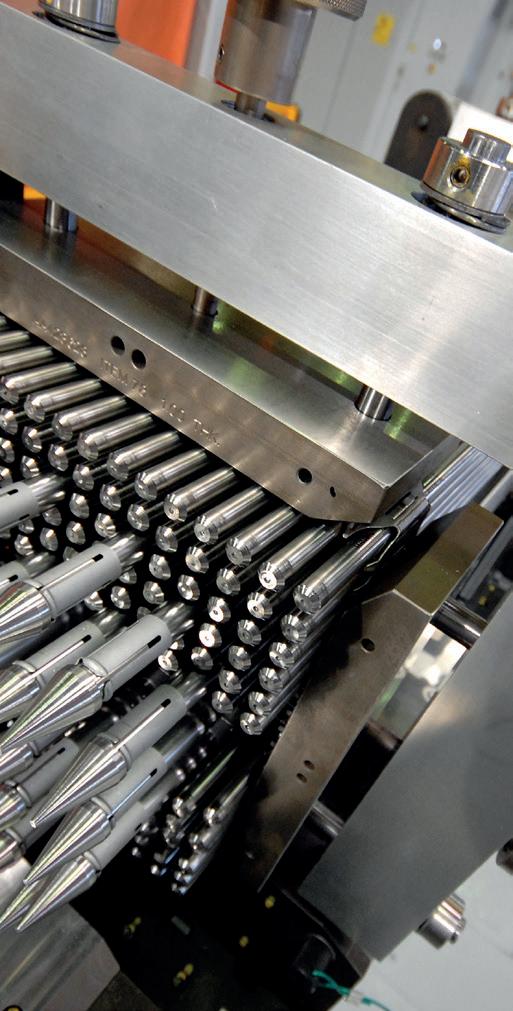
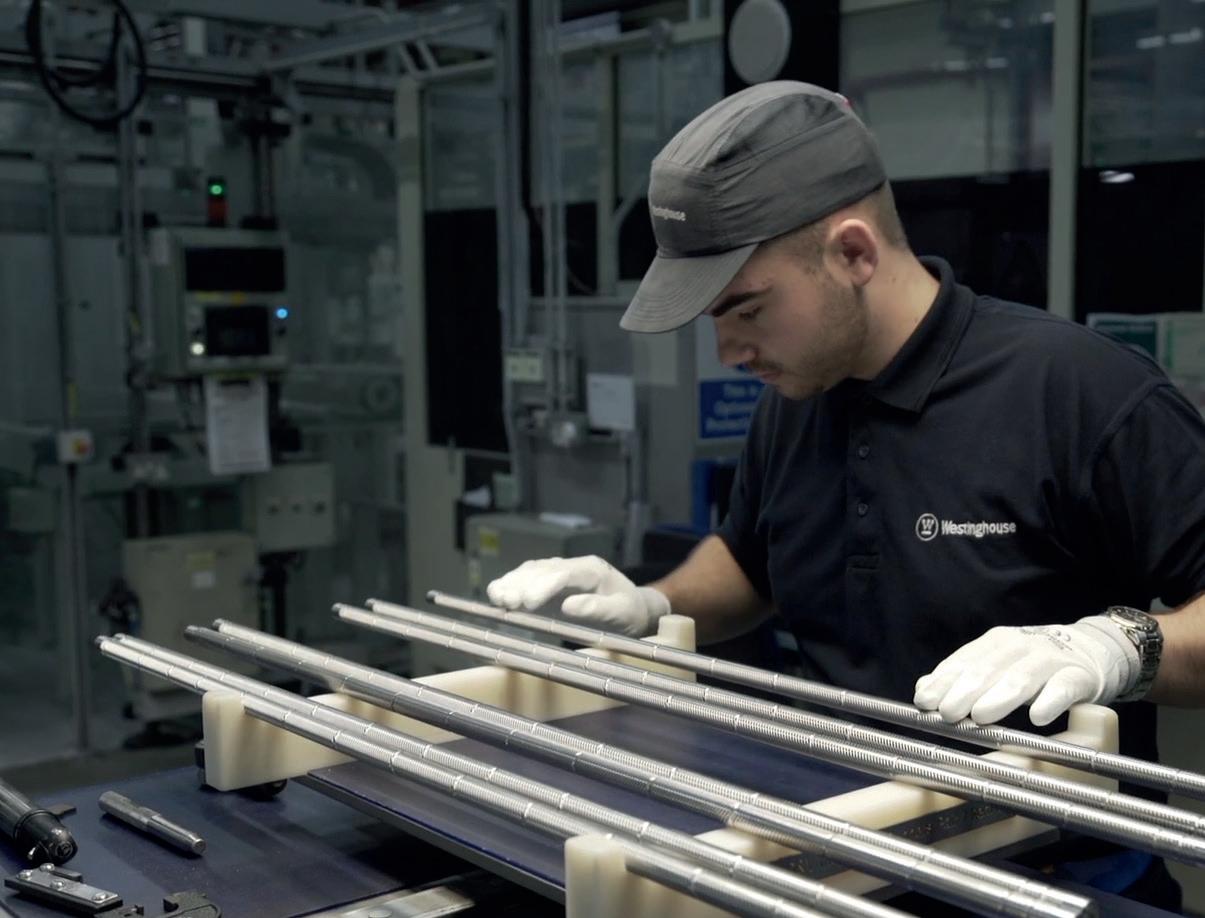
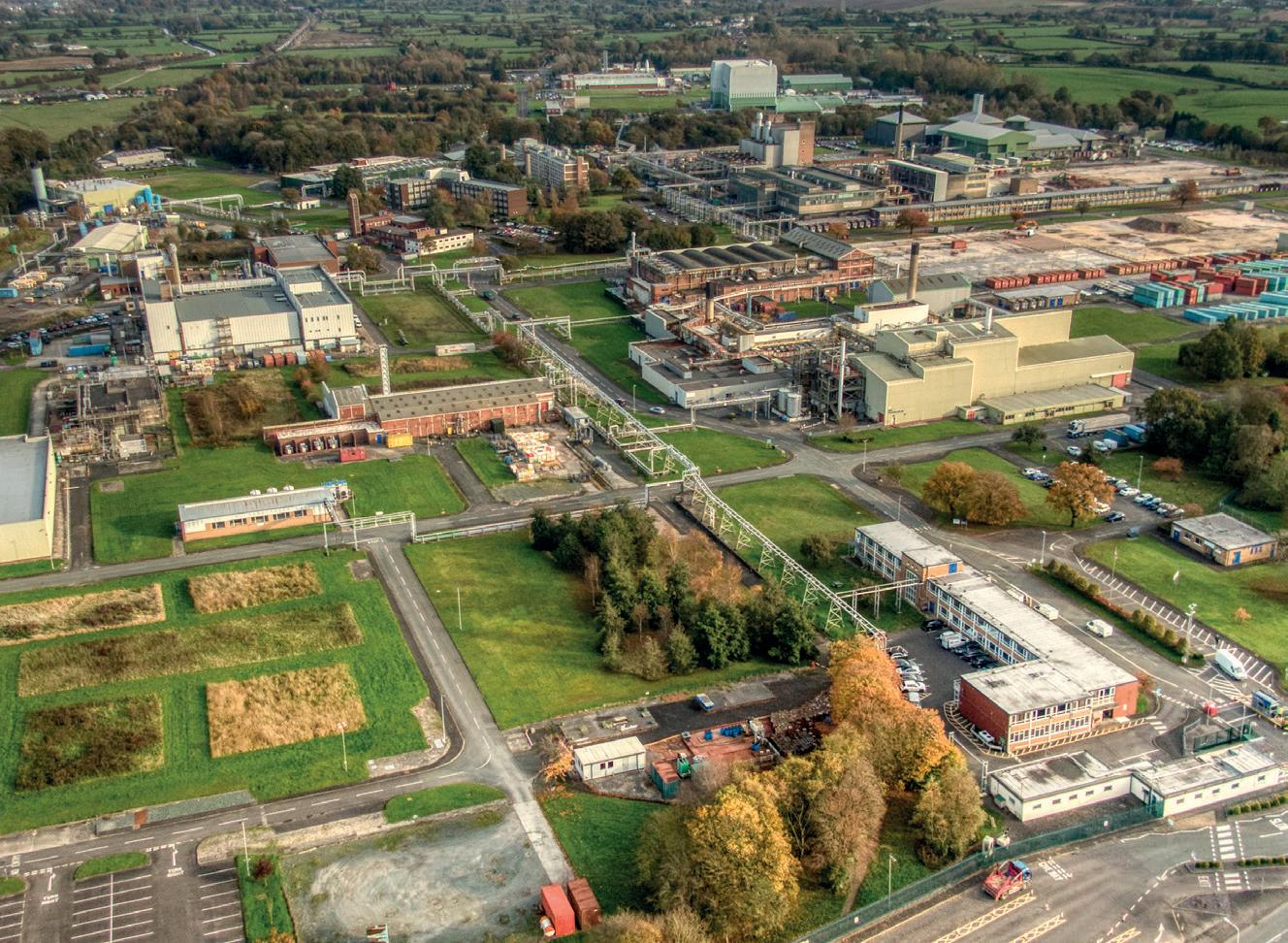
Scan the QR code to read the APPG Russia report. For more information contact jon.woodburn@niauk.org
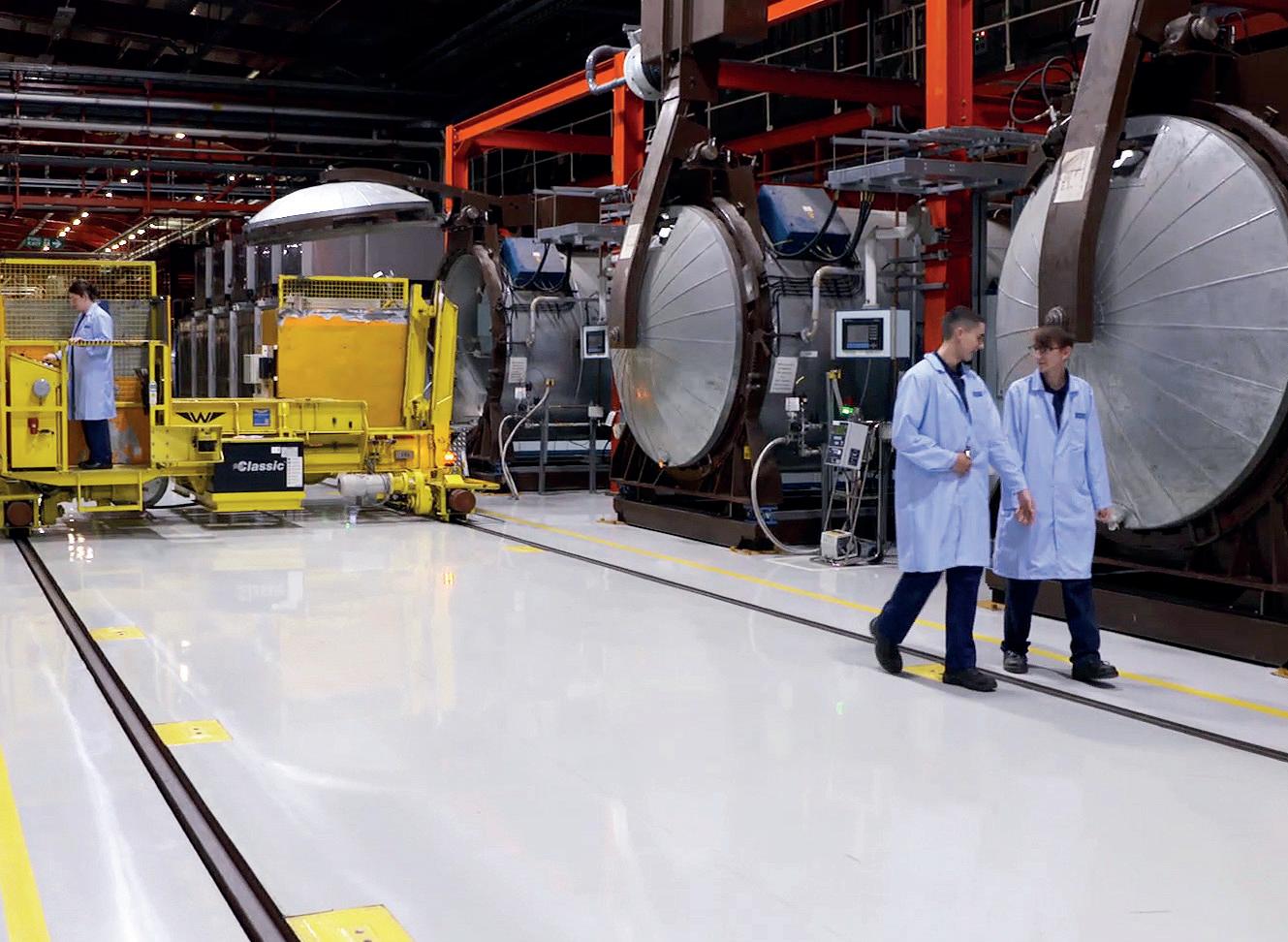
2022 | WINTER — 3
Read the report > All-Party Parliamentary Group on Nuclear Energy September 2022 Resisting Russia’s Energy War: UK Nuclear Investment for Allied Energy Security ▲ Enrichment workers at Capenhurst ▲
Fuels facility ▲ Nuclear fuel manufacturing
Springfields
Hinkley Point C smashes apprenticeship milestone


From the very beginning, Hinkley Point C has set out to maximise opportunities for local people, so reaching its target of creating 1,000 apprenticeships has been a major success, writes Freya Lee from the Hinkley Point C team.

When plans were being drawn up for the nuclear power station in Somerset, ambitious targets were set to train 1,000 apprentices during the construction phase. Fast forward to 2022, and the project is celebrating exceeding that target ahead of schedule.
The milestone has been hit earlier than expected due to the work being done with local schools and colleges. The project’s outreach teams are dispelling outdated views on apprenticeships, showing how
they are opportunities to learn valuable skills, while earning good money.
The apprenticeship programme is designed to bolster Britain’s nuclear and construction industries, and, with more nuclear projects on the horizon, the courses also offer career futureproofing.
For many of the leaders at Hinkley Point C, the mission to develop apprentices on the project is personal. The Delivery Director, Nigel Cann started his own career as an apprentice before rising through the ranks to become station director at Hinkley Point B, before taking up his current post.
4 — WINTER | 2022
LEE • EXTERNAL COMMUNICATIONS MANAGER • EDF
FREYA
“I’M PROUD THAT WE’VE HIT THIS IMPORTANT MILESTONE JUST SIX YEARS INTO CONSTRUCTION—AND I KNOW THAT OUR PROGRAMME WILL KICK START SO MANY EXCITING CAREERS IN THE NUCLEAR INDUSTRY”
The apprenticeship programme is making a tangible difference in Somerset, with two thirds of all apprentices living within the local area. Opportunities are open to people regardless of their previous experience and background. Apprenticeships are not just for the younger generation, either—they also offer a chance to retrain in a new career. The youngest apprentice currently working on the project is eighteen, and the oldest is in their fifties.
Charlotte Casey, 22 and from Bridgwater, completed a nuclear engineering degree apprenticeship and now works as an Operational Development Engineer on site. She would have needed to move elsewhere in the UK for similar opportunities.
“THE PROJECT HAS MADE A MASSIVE DIFFERENCE TO PEOPLE IN MY LOCAL AREA. LOTS OF MY SCHOOL FRIENDS DIDN’T GET MANY GCSES, BUT THEY’RE NOW WORKING ON SITE AND GAINING SKILLS, WHILE MAKING A GOOD INCOME. IT’S GOOD FOR OUR CAREER PROSPECTS TOO, BECAUSE WE’LL TAKE WHAT WE’VE LEARNED ONTO FUTURE PROJECTS, WHEN THIS IS FINISHED”.
With a workforce of 8,000 people, vital support services are needed to keep the site running— such as the bus service, catering, administration, and HR. Apprenticeships are being offered in each of these disciplines, ensuring there is a course for everyone.
These opportunities are being taken up by people like Mat Danby, 28, who is working as a chef apprentice with Somerset Larder, which provides the on-site catering for workers.
“BEFORE I CAME HERE, I WAS FRYING CHICKEN IN KFC—AND NOW I’M MAKING MEALS FOR HUNDREDS OF HARDWORKING PEOPLE EVERY DAY. THE BEST BIT ABOUT MY JOB IS THE TRAINING AND DEVELOPMENT OPPORTUNITIES I’M BEING GIVEN. SEEING THE WORKFORCE ENJOYING MY FOOD AFTER DAY WORKING OUT ON SITE REALLY TOUCHES MY SOUL.”
The apprentices benefit from world-class training equipment—with Hinkley Point C investing £8 million into three “Centres of Excellence” in Somerset, specialising in welding, mechanics, and electrics. The project has also developed other career pathways for people, including T-levels, the technical alternative to A-Levels, and Supported Traineeships for people with learning difficulties.
Hinkley Point C isn’t stopping at the 1,000 milestone and will continue to add to its ever-growing tally. Apprenticeship opportunities will continue to be available on the project as construction develops and beyond—when the power station starts to produce electricity. Those skills will also benefit follow-on new nuclear projects, as well as the UK’s engineering and construction industries well into the future.
Media Watch
As the voice of the civil nuclear industry, one of the NIA’s important functions is to the gauge the temperature of how the sector is reported in the media. Some publications have traditionally had a tendency to be kinder than others, so it was very welcome to see The Observer, the Guardian’s Sunday edition, show support for nuclear in an editorial in November. Despite a somewhat mixed relationship with nuclear, the paper called on the government to “act with a speed that will provide the country with sufficient nuclear electricity— and keep the lights on over the next two decades.” The same weekend, the Financial Times penned its own pro-nuclear editorial, saying, the “UK should commit to nuclear as a baseload power generator.”
Hinkley Point C’s female workforce was recently featured in the brilliant ‘We are England’ BBC documentary, which followed the lives of four workers from across the site: steel fixer Stacey Sowden, trainee reactor operator Janaan Hussain, HR apprentice Courtney Cook and field engineer Bogdana Stîngā. Ms Sowden said she was the “only female in her team”. The former professional footballer joined the construction site as an apprentice two years ago and now works to move huge, prefabricated steel bars to build the colossal frames that will form the backbone of the site’s reactors. Most of her work was completed on Nuclear Island 1, one of the site’s two 32-metre high reinforced concrete shells that will contain a nuclear reactor.
In October, the NIA’s Tom Greatrex appeared on Al Jazeera to talk about Sizewell C and other UK nuclear projects as part of a series of interviews and reports on global nuclear policy. Tom described how the need for a fleet approach is vital and if we had done that 10-15 years then we wouldn’t be in this position now, facing a difficult winter. The channel reaches more than 270 million households in over 140 countries around the globe from its HQ in Doha.
A clip of new Prime Minister Rishi Sunak during his first PMQs session in the Commons broke NIA social media records, becoming the most popular Twitter and LinkedIn posts in the Association’s history.
The clip, in which Mr Sunak says “The important thing is to focus on our long term energy security. That means more renewables, more offshore wind and indeed, more nuclear,” was viewed over 100,000 times and is the NIA’s most popular and wifely shared social post in its history. When the PM says something, people take notice. More of this please Mr Sunak!
Tom Greatrex also appeared on Sky News’ The Great Debate show to discuss the prospect of blackouts this winter. He said the reason why we’re facing a winter like this one, with the lights potentially being switched off, is a lack of proper planning from previous governments.
The prospect of tight energy supplies this winter, he said, “wasn’t unpredictable - in fact it was predicted.” That’s why those in power need to look at long-term energy policy as well as what’s happening in the here and now.
2022 | WINTER — 5
IOLO JAMES • MEDIA & COMMUNICATIONS MANAGER • NIA
For full versions and more details on these and other stories visit www.world-nuclear-news.org
Ghana SMR deployment
The USA, Japan and Ghana have announced a strategic collaboration to support the deployment of SMRs. Through the partnership, Ghana could become an advanced nuclear technology hub.
The announcement reaffirms commitments by Japan and the US to energy innovation, energy security, and global clean energy transition in a smart, cost-effective, and secure way by advancing the latest technology and commercial leadership in emerging technologies that provide firm, reliable electricity and industrial heat.
Holtec completes district heating design
Holtec International has completed the design and computer simulation phases for its HI-HEAT district heating system. HI-HEAT is the lowpressure steam supply version of the company’s Green Boiler which it is developing to store surplus electricity generated by nuclear, solar or wind.
According to Holtec, HI-HEAT can provide a carbon-free solution for district heating in countries facing gas supply shortages as well as countries
aiming to shrink the footprint of fossil fuels in their national economies.
A single shop-manufactured module can store more than 300 million BTUs of thermal energy in its capacitor which is enough to produce 300,000 pounds of steam.
Westinghouse to build Poland’s first NPP
US firm Westinghouse has been chosen to build Poland’s first nuclear power plant
It was announced in September 2021 that six pressurised water reactors with a combined installed capacity of 6-9 GWe could be built by 2040 as part of Poland’s plan to reduce its reliance on coal. According to the adopted schedule, the construction of the first plant will start in 2026, with the first reactor, with a capacity of 1-1.6 GWe, being commissioned in 2033.
In July last year, Westinghouse announced the launch of front-end engineering and design work—based on AP1000 technology—under a grant from the US Trade and Development Agency to progress the nuclear energy programme in Poland.
The coastal towns of Lubiatowo and Kopalino in Poland’s Choczewo municipality have been named as the
preferred location for the country’s first large nuclear power plant.
Global Nuclear Fuel and TerraPower Announce NatriumTM Fuel Facility
The Natrium Fuel Facility will be jointly funded by TerraPower and the U.S. Department of Energy (DOE) through the Advanced Reactor Demonstration Program, which aims to speed the demonstration of advanced reactors through cost-shared partnerships with U.S. industry. The facility represents an investment of more than $200 million.
The Natrium Fuel Facility and other commercial nuclear power initiatives are projected to grow workforce by approximately 500 new employees over five years. Many of these new employees will support the Natrium reactor technology that is being jointly developed by GEH and TerraPower as well as other commercial nuclear power initiatives.
In 2021, TerraPower announced its intention to build the first Natrium reactor at a retiring coal facility in Kemmerer, Wyoming.
Construction on the Facility is anticipated to begin in 2023 and, once complete, is expected to support up to 100 new, permanent jobs.
6 — WINTER | 2022
Power prices peak amid energy market chaos
2022 has been a year like no other in the price of electricity, with the war in Ukraine and poor long-term planning to blame, writes the NIA’s Jake Moorman. 08/03/2022 £396 09
At the end of each year, it is always interesting to look back over the events of the past twelve months and reflect on all that has happened. In 2022, the twists and turns have made for compelling analysis. At the NIA we have been keeping a careful eye on the price of power in the UK and for a long time we have been predicting a significant rise in energy costs. This year, our predictions were realised, but on a scale that no-one had fully anticipated.
Entering the new year there was a real sense of optimism around the country. We were finally emerging from the shadow of Covid-19 and looking forward to the postpandemic era. Despite the general positivity, the energy markets were looking a little shaky on the back of a cold winter in the northern hemisphere. The day-ahead power price for New Year’s Day was a modest £69/MWh, a surprisingly good start, but it wasn’t to last. Within two weeks the price had risen to £311/MWh, setting the precedent for what would prove to be a roller-coaster year.
January also saw us bid farewell to Scotland’s most valuable clean energy asset, Hunterston B. The power station provided the UK with clean energy for 46 years, producing 297.4 TWh of electricity. It was the second of the AGR fleet to retire after Dungeness B went into defueling in 2021, leaving the UK with just six generating nuclear power stations.
The loss of Hunterston B certainly didn’t help the situation. A reduction in our nuclear capacity means we are even more reliant on expensive gas to plug the gap, with just balancing the grid becoming extremely costly; around £10,000,000 a day for the first two months of the year. Then, to make matters worse, at the end of February, Russia invaded Ukraine in an appalling move that sent shockwaves all around the world. The impact on the energy market was seismic.
Countries rightfully made the decision to boycott Russian energy, but at a significant cost. March saw unprecedented power prices with an all-time high of £396/MWh on the 8th and a record monthly average of £250/MWh.
As we headed for summer, prices stabilised slightly, by 2022 standards anyway, with the average cost in May and June down 43% compared with March. Sadly though, it was not to last, with July seeing prices ramping up yet again.
Continued pressure from the effects of Putin’s war, coupled with record summer temperatures—therefore an increase in air-conditioning use—in the northern hemisphere, and countries looking to replenish their gas stocks ahead of the winter, reversed the decline seen earlier in the Summer. It drove prices back up to almost where they were in March. By this point it was clear that
26/08/2022 £571.09
the UK was far too vulnerable to the international energy markets, we needed home-grown energy sources like never before.
Therefore, the retirement of Hinkley Point B nuclear power station in August was an untimely loss of firm, sovereign power. The station is the UK’s most productive clean-energy asset ever, generating 311 TWh of electricity over its 46-year lifetime. The Somerset station’s successor, Hinkley Point C, is due to come online in June 2027 and for British energy security, that date cannot come quick enough.
Removing Hinkley Point B’s two reactors from the national grid further put the UK at the mercy of international gas prices . Power prices in August completely smashed March’s record, rising by 43%, with a monthly average of £370/MWh and a maximum daily cost of £571/MWh on the 26th. In context, the average price in August 2022 was 246% higher than the previous year, a very alarming statistic.
Thankfully, September provided some respite, but prices remained higher than they had been in March. At the end of September, the National Grid published its Winter Outlook report, with warnings of power cuts in the UK and a potential lack of supply from continental Europe with planned outages on the French nuclear fleet. The forecast was bleak.
However, an uncharacteristically mild and windy autumn provided the UK with the lifeline it needed after the turbulent first nine months. Power prices fell dramatically, with October being the first month of the year where costs were lower than they were at the same time in 2021. More good news came in the form of EDF’s stated ambition to extend the operating lifetimes of Heysham I and Hartlepool power stations beyond March 2024. With only five operating power stations left in the UK’s fleet, an extension could be crucial to mitigating against any future volatility.
As we approach the end of the year with the power price hovering around £100/MWh, the optimist in me hopes that 2023 will provide a more stable energy market. Realistically, only time will tell. However, the most important lesson from this year is that our reliance on gas has left us at the mercy of volatile energy prices and the resulting increase in the cost of electricity has been alarming.
In a world of increasingly unpredictable weather, we cannot continue to rely on the climate to bail us out. Most autumns will not be as mild as this one and the wind may not blow as favourably as it has recently. Therefore, more than ever, we need a secure and reliable source of affordable energy which only British nuclear power alongside renewables can provide.
2022 | WINTER — 7
£100.00 £200.00 £300.00 £400.00 £500.00 £600.00
Power Prices in 2022 Day-ahead Price (£/MWh) 7-day Rolling Average of Power Prices (£/MWh)
Building a secure and resilient security infrastructure
In 2021, the Office for Nuclear Regulation (ONR) received 456 incident notification forms documenting security issues at UK nuclear facilities, these included physical security issues such as unauthorised people gaining unsupervised access to secure areas, as well as cybersecurity issues such as malicious software attacks. Although the majority reported were minor, the figures have more than doubled since 2018.
In these scenarios, time is the most important element and nuclear plants are taking both physical as well as cyber security measures to prevent such incidents. By building a future proof, intelligent communications plants can create a barrier to unwanted unauthorised physical entries or data access and theft. But how?

Emergency preparedness: Start with building a solid foundation

A nuclear organisation faces the same challenges as any commercial organisation: ensuring compliance with changing regulations, meeting sustainability goals, and maintaining strict budgetary controls that ensure healthy returns on investment without compromising on safety.
Ensuring a positive outcome can be addressed by tackling key challenges within a digital transformation strategy and developing an open, standardsbased communications ecosystem that is scalable, drives efficiency, supports data sharing and innovation.
One of the major challenges is the variety of options available that can make selection challenging. The nuclear industry does not have a single set of needs, rather, each operational area has different expectations.
So, how do you ensure every users needs are met? Safety and emergency preparedness are the first priority, followed closely by highly redundant
8 — WINTER | 2022
JENKINS • SENIOR BUSINESS MANAGER & SERVICE DELIVERY MANAGER FOR SELLAFIELD • RADIOCOMS
PAUL
communications architecture to ensure the required levels of resilience, interoperability with public safety to ensure appropriate coordination and security to handle the full scope of daily operations and unimaginable disasters.
In addition to protecting investments and employees, communications systems can also protect against criminal and terrorist threats. In today’s technologically advanced world, network security threats are increasing, and cyber-attacks are becoming more common, so any system must be secure against being mis-used.
Furthermore, maintenance operations as well as surveillance inspections should be carried out on a regular basis and compensatory measures put in place whenever a system is rendered unavailable.
Smarter connectivity: Flexibility & scalability for the future
A well-balanced combination of innovative and proven technologies is essential to improving safety. Today’s communication technologies are no longer limited to simple push to talk systems. Powering faster, more informed decision-making are the advancements in DMR/TETRA radios and LTE smart devices for example, the sharing of video and data communications alongside instantaneous voice broadcasts, whilst technologies such as satellite devices guarantee continuity during a critical incident.
Connect people, products, and processes
The operation of nuclear power plants requires careful attention for employee, plant and data safety and security however, plant critical information can be siloed by the use of multiple devices,
networks, and technologies creating reactive not proactive situations. Taking advantage of intelligent infrastructure by connecting with applications, SCADA and IIoT they can turn data into insight to support streamlined workflows, smarter decision making, and post-incident analysis.
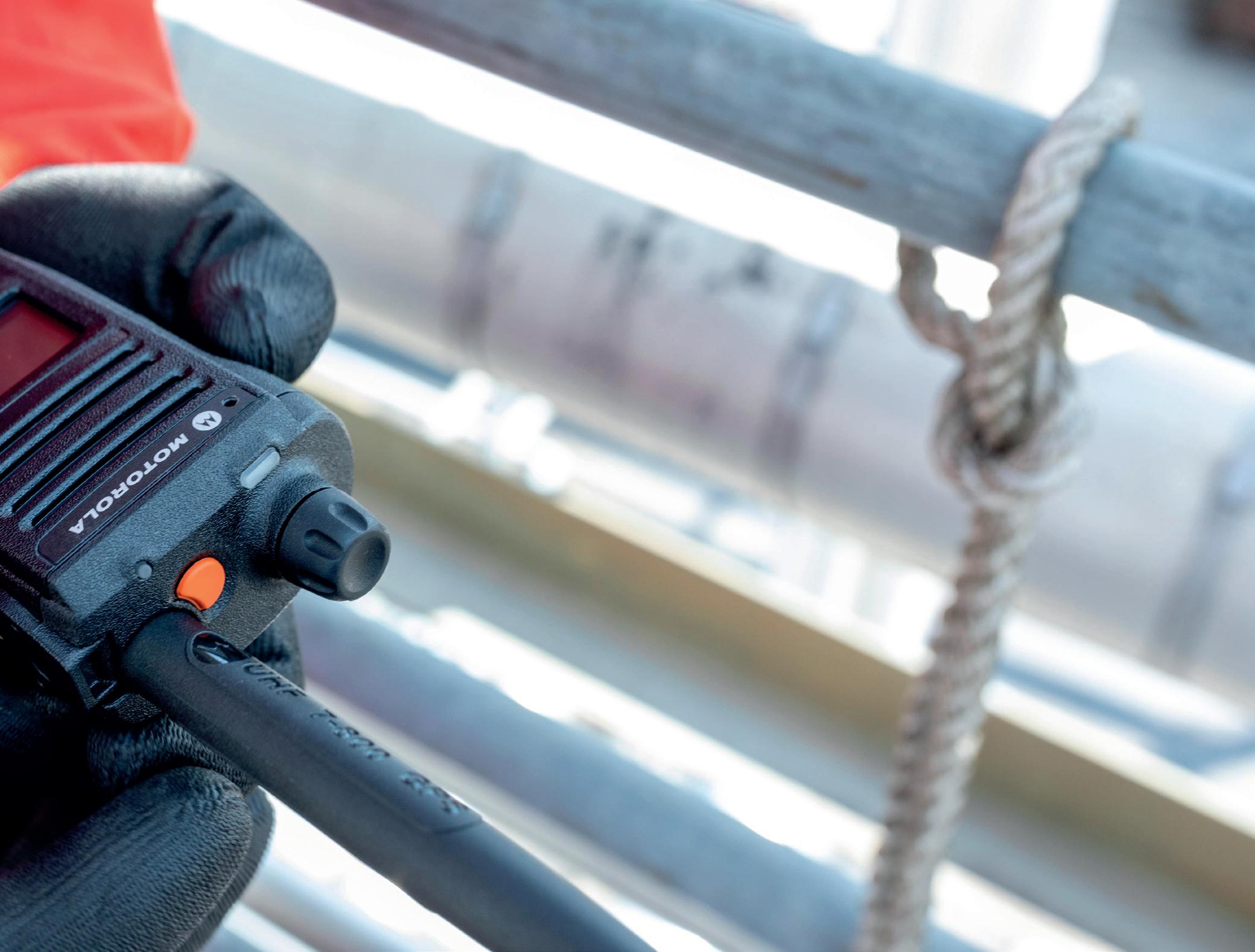
Although often reluctant to move away from legacy systems and processes due to a lack of organisational capability, or uncertainty in platform standardisation, the leveraging of new technologies to include features such as automation and optimisation can help to tackle challenges and prepare for the future.
Providing instant information via one central platform
When operating large and complex physical networks information is a key tool. With the introduction of data into communication systems, plants have seen faster decision making and the early identification and prevention of potential problems, for example, site monitoring and protecting lone workers in real time, notifications delivered directly to devices of alarms to providing engineers full sight over every job and its status through workforce management software.
When implemented correctly software can empower employees by giving them the tools to work in a secure and managed environment thus improving satisfaction, retention, and productivity.
To conclude. Any highly scalable and resilient solution should be able to offer any of the above, however, we do understand the security and integrity of data is one of the biggest concerns for most of our clients and the implementation of any changes should be accompanied by effective processes to ensure pre-consultations are carried out.
2022 | WINTER — 9
Delivering excellence at AWE
Caring for the environment
When it comes to the environment, AWE takes its responsibility in caring for it seriously—and in doing so, the company remains committed to sustainability, protection, climate change and reducing energy consumption. These areas are vital to maintaining outstanding environmental performance and sustainability as part of AWE’s business operations, regulatory obligations and future investments.

Complying with environmental standards
AWE continues to make environmental improve ments—demonstrated by its ongoing certification to the internationally recognised standard ISO 14001:2015 Environmental Management Systems (EMS). The EMS provides a framework to protect the environment and respond to changing environmental conditions alongside socio-economic considerations. We have a wide range of Environmental Permits granted by the Environment Agency. Implementation of the EMS and compliance with the Permits is supported by a dedicated team of highly skilled and knowledgeable environmental specialists and waste officers who are embedded throughout the business.
Environmental sustainability
In 2020, AWE refreshed its approach to environmental sustainability setting ambitious goals and targets. Following the UK government’s commitment to Net Zero Carbon and AWE’s transition to a non- departmental public body, a significant update has been undertaken following
engagement with key stakeholders and the completion of a Materiality Assessment. Our strategy in environmental sustainability and protection focusses on three key themes: reducing carbon; implementing the circular economy; and enhancing biodiversity.
The Environmental Sustainability Strategy is integrated into AWE’s business plan, with the aim to have outstanding environmental performance recognised by everybody. This will include a physical site and workforce which fully embraces and meets climate and other environmental challenges; sustainability principles that are integrated into all activities and employees who work for a business of which they are proud and is prepared to tackle key environmental issues.
Strong leadership is instrumental to the successful implementation of the Strategy. Innovation and transformation are required to embed sustainability into our systems, processes, and procedures, creating behavioural changes through a culture of care and responsibility. An Environmental Social Governance (ESG) Committee has been established, responsible for setting the strategic direction for ESG, which is chaired by an Executive Director.
Sustainability
10 — WINTER | 2022
“ALTHOUGH THESE ACHIEVEMENTS DEMONSTRATE PROGRESS AND DELIVERY, IT IS RECOGNISED THERE IS MORE TO BE DONE, ESPECIALLY TO ACHIEVE NET ZERO CARBON. MORE INNOVATIVE AND CREATIVE WAYS TO REDUCE AWE’S CARBON FOOTPRINT ARE BEING EXPLORED—AS PART OF FUTURE ASPIRATIONS.”
Helen Gladwinfield, AWE Lead for Environmental
DAVE ALLEN • NICK DEAVIN • HELEN GLADWINFIELD • SUZANNE OWEN • CHRIS PARRY • AWE PLC
Carbon Management Strategy
As a Non-Departmental Public Body, we are working on developing initiatives which align to the Ministry of Defence’s Climate Change and Sustain ability Strategic Approach, including contributing to Net Zero by 2050.
Like many businesses, we are aware that achieving this goal will be challenging but we are committed
to setting ambitious targets and creating a rigorous roadmap to support our journey.
We have developed science-based targets to ensure our carbon reductions are in line with the goals of the 2015 Paris Agreement, and we commit to take action to help tackle climate change and create a sustainable future for generations to come.
AWE CARBON MANAGEMENT ACTIVITIES
2022 | WINTER — 11 Areas of Focus Changing how we procuretoembed decarbonisation andthe principles of the circular economy Reducing carbon emiss ions by c hoosing more sustainable way s to trave l Creati n g a culture of caretodrivebehaviouralchange Leadership&Culture SupplyChain Travel & Transp ort SourcesofEnergy The BuiltEnvironment Optimising our estate wewillreduceourcarbonfootprint as we cl ose o r upgrade old, inefficientfacilitiesandbuild modern , efficient faci l i ti e s Minimisingourscope1&2carbon emissions throughthe sourcesandsupplyof energy DREAM excellent for new builds and very good for refurbishments Purchasing renewable energy Start remediation work Installing low NOx burners into the Boilerhouse Low carbon sources of heat e.g. electrification Purchase Power Agreement for off-site solar farm People know the right things to do Governance & decision making Embed sustainability requirements into our systems Designing buildings to improve energy efficiency Employee commuting: liftshare scheme Installation of EV charging points Transition of AWE vehicle fleet Reduction in domestic flights Sustainable Procurement Policy Embedding circular economy Working with suppliers who share our goals Investment in Low Zero Carbon technologies KEY ENVIRONMENTAL
INITIATIVES
Operating and maintaining a CMS
AWE is required to operate and maintain a Company Management System (CMS) to maintain safe and secure operations—without the CMS the company cannot function. The CMS is a framework of policies, processes and procedures that helps us to fulfil all the tasks needed to achieve the company’s objectives, and to adhere to strict legal and regulatory requirements.
The CMS is the foundation for ‘how we do things’ in the areas of Environment, Safety, Health and Quality (organisationally referred to as ESH&Q) at AWE. It is also vital for business requirements in the areas of Operations, Security, Finance and HR. As a nuclear licensed site, AWE must demonstrate to stakeholders and regulators that it has robust processes in place that are maintained and controlled in accordance with licence conditions.
We collaborate with organisations across the nuclear enterprise and wider—and are always keen to learn from the experience of others. AWE’s specialists share their knowledge and expertise of the CMS, in helping to drive continuous improvement and promote best practice in the nuclear sector, which, in turn, brings benefit to UK industry.
We have been able to establish realistic improvement targets for our documented information, for example 95% of AWE’s documents are reviewed within agreed timescales.
Whilst AWE uses different software packages, with varying levels of complexity, the company’s principles for operating and making CMS practical for end users are similar to those adopted in other nuclear organisations. For example, the software packages all contain similar hierarchies of processes listed on a front page. Change is managed by similar proportionate controls, and the systems hold company level documents— those documents that are used by more than one team. Information about specific methods used to carry out activities, like work instructions, are maintained by the teams that use them, either in SharePoint or in their manufacturing systems.
It is often the small, simple ideas which have had the biggest impact on improving the CMS. For example, we incorporated the use of colour coded headers to distinguish the different document types for its users and this approach has helped to drive consistency within the CMS.
“AS A CONSEQUENCE, USERS CAN EASILY CONFIRM THAT THEY ARE LOOKING AT THE CORRECT TYPE OF DOCUMENT TO MEET THEIR NEEDS—SUCH AS A ‘POLICY’ IF THEY WANT TO UNDERSTAND GOVERNING PRINCIPLES; ‘STANDARD’ IF THEY NEED TO UNDERSTAND MANDATORY REQUIREMENTS; OR ‘PROCEDURE’, IF THEY WANT TO SEE HOW TO CARRY OUT AN ACTIVITY.”
“WE RECOGNISE THE VALUE AND IMPORTANCE OF COLLABORATION WITH OTHER NUCLEAR INDUSTRIES, AS WE SHARE COMMON ISSUES AND SUPPLY CHAIN. LEARNING FROM EACH OTHER’S EXPERIENCES AND HOW WE GO ABOUT DELIVERING ENABLES US TO VALIDATE WHAT WE ARE DOING OR MAKE ADJUSTMENTS TO CONTINUOUSLY IMPROVE OUR ARRANGEMENTS.”
Chris Parry, AWE Infrastructure Projects Delivery Quality Lead
Demonstrating best practice in estate management
Suzanne
Owen, AWE Lead for Core Quality
These simple ideas and improvements to the CMS are helping to deliver efficiencies across AWE—whilst also demonstrating the importance and value of a system in which everybody can have confidence.
Delivery quality and sharing knowledge
We invests significantly in delivering Quality in our processes, operations, and practices as part of our mission.
Experts in Quality continue to engage with other industries, whether it is in the Safety Directors’ Forum or the Submarine Enterprise Quality Group, where joint Quality arrangements are agreed for interaction with the Supply Chain— to share learning and deliver value across the nuclear enterprise.
AWE and Sellafield are collaborating on a series of topics such as Management Systems, Quality Control Grading, Project Quality, Public Procurement Regulations, and the role of the Intelligent Client. The collaboration is helping to identify common themes in ‘nuclear quality’, areas of key focus and where organisations need to adapt and embrace new ways of working.
In August 2020, the ONR extended a review of nuclear power plant ageing management plans to other nuclear site licensees including AWE.
We produced a comprehensive self-assessment report that covered the progress of the organisational and process updates to a throughlife asset management model aligned with industry best practice in the form of ISO 55000.
The improvements encompass all AWE site operations and intend to drive an optimisation of the ageing infrastructure to a more modern, efficient and effective means to deliver the current programme safely and securely—with a vision for the future.
Work on delivering improvements
continues at pace and progress is periodically shared and discussed through the Nuclear Engineering Directors’ forum. AWE continues to transform its business—with an exciting future ahead in the nuclear sector and wider industry.
www.awe.co.uk/careers Follow us on Twitter
12 — WINTER | 2022
“DRIVING TO A PROACTIVE THROUGH-LIFE MANAGEMENT MODEL IS KEY TO ENABLE FUTURE SUCCESS OF MANAGING COMPLEX SITES SUCH AS OURS.”
Nick Deavin, AWE Senior Maintenance Authority
@AWE_plc
Peterson is the solutions-focused supply chain architect trusted to support the global energy industry. We have a proven pedigree in the nuclear sector, providing supply chain control tower management together with supporting technologies to control site traffic flow and ultimately helping to improve overall supply chain efficiency.
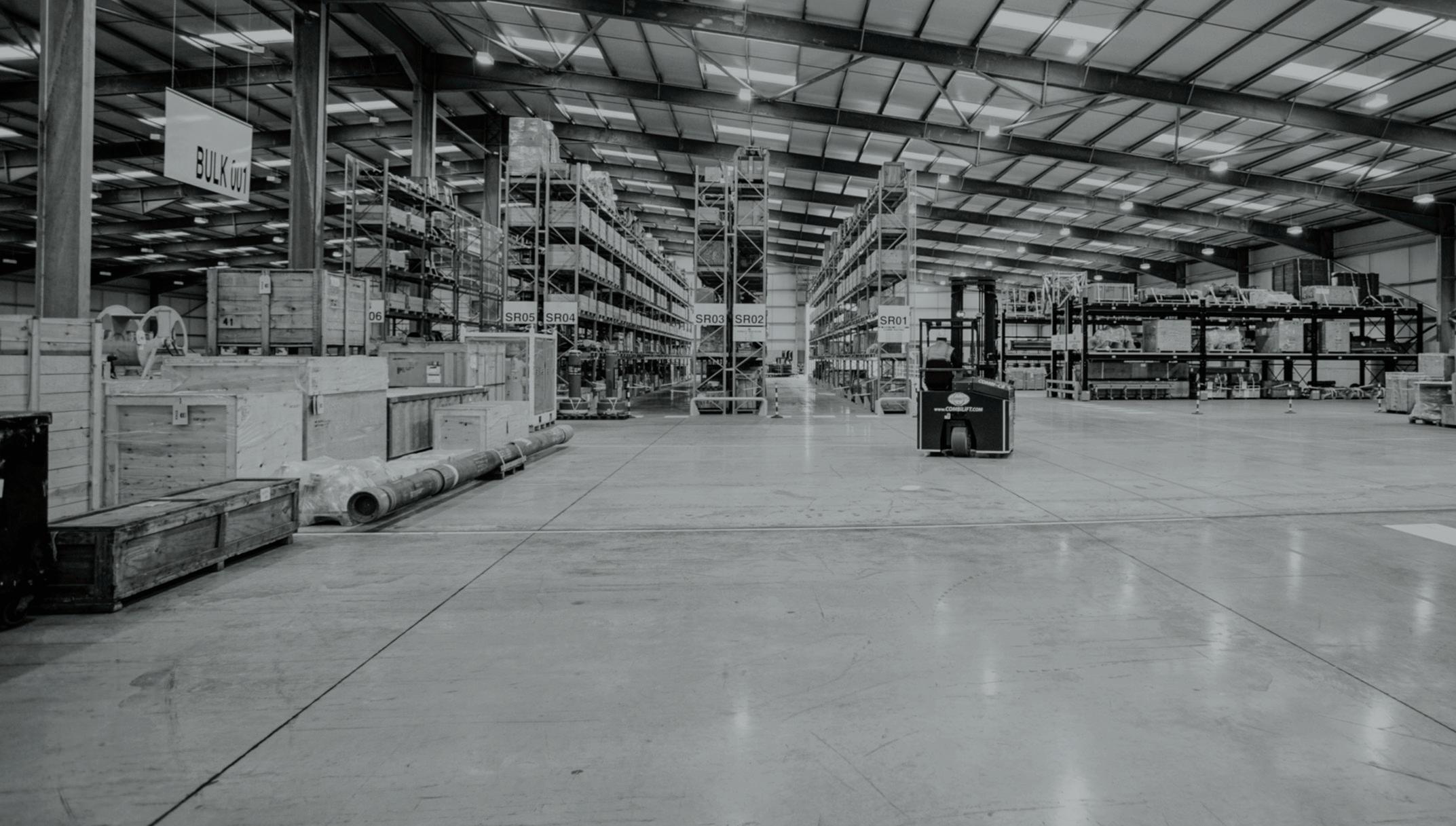
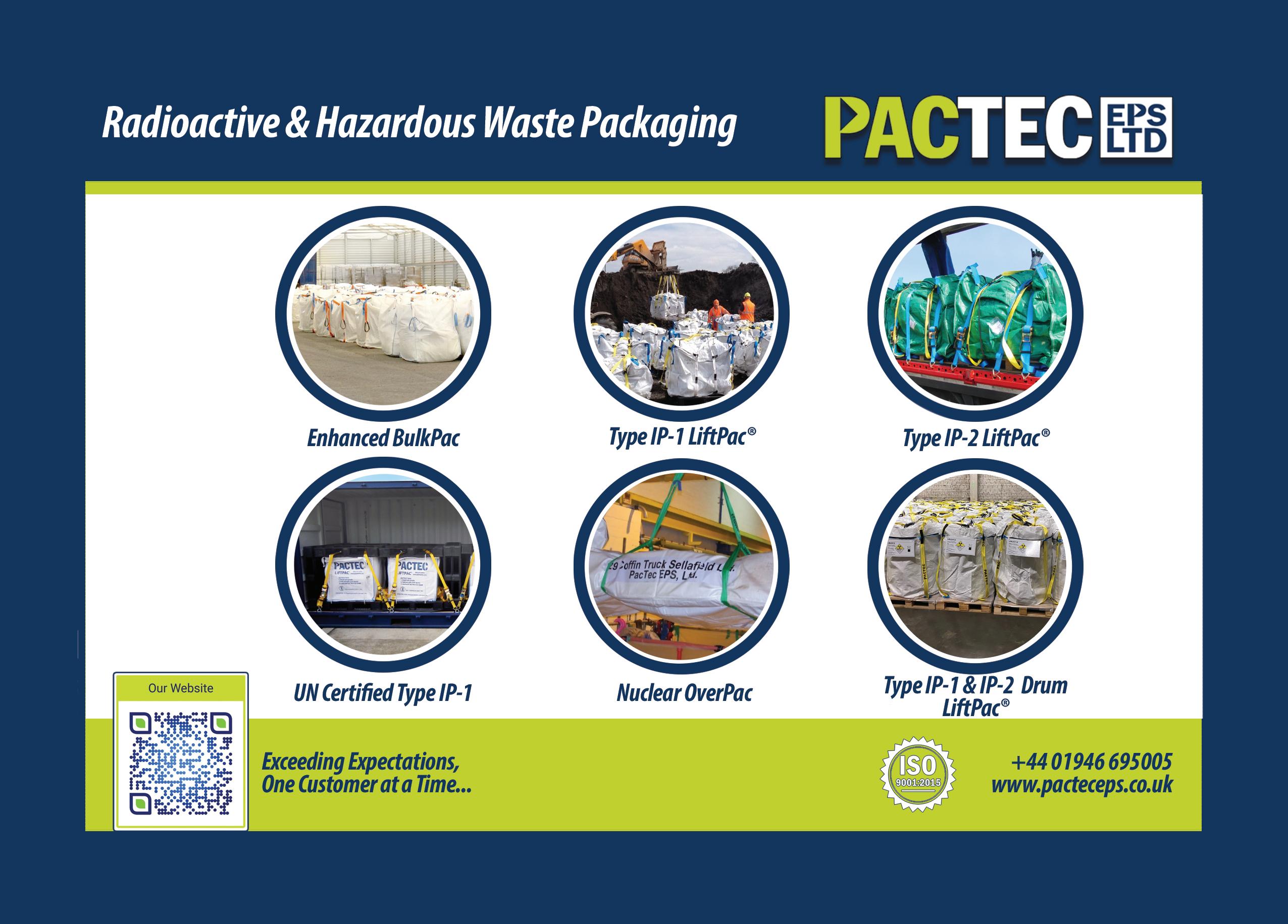
energylogistics.onepeterson.com
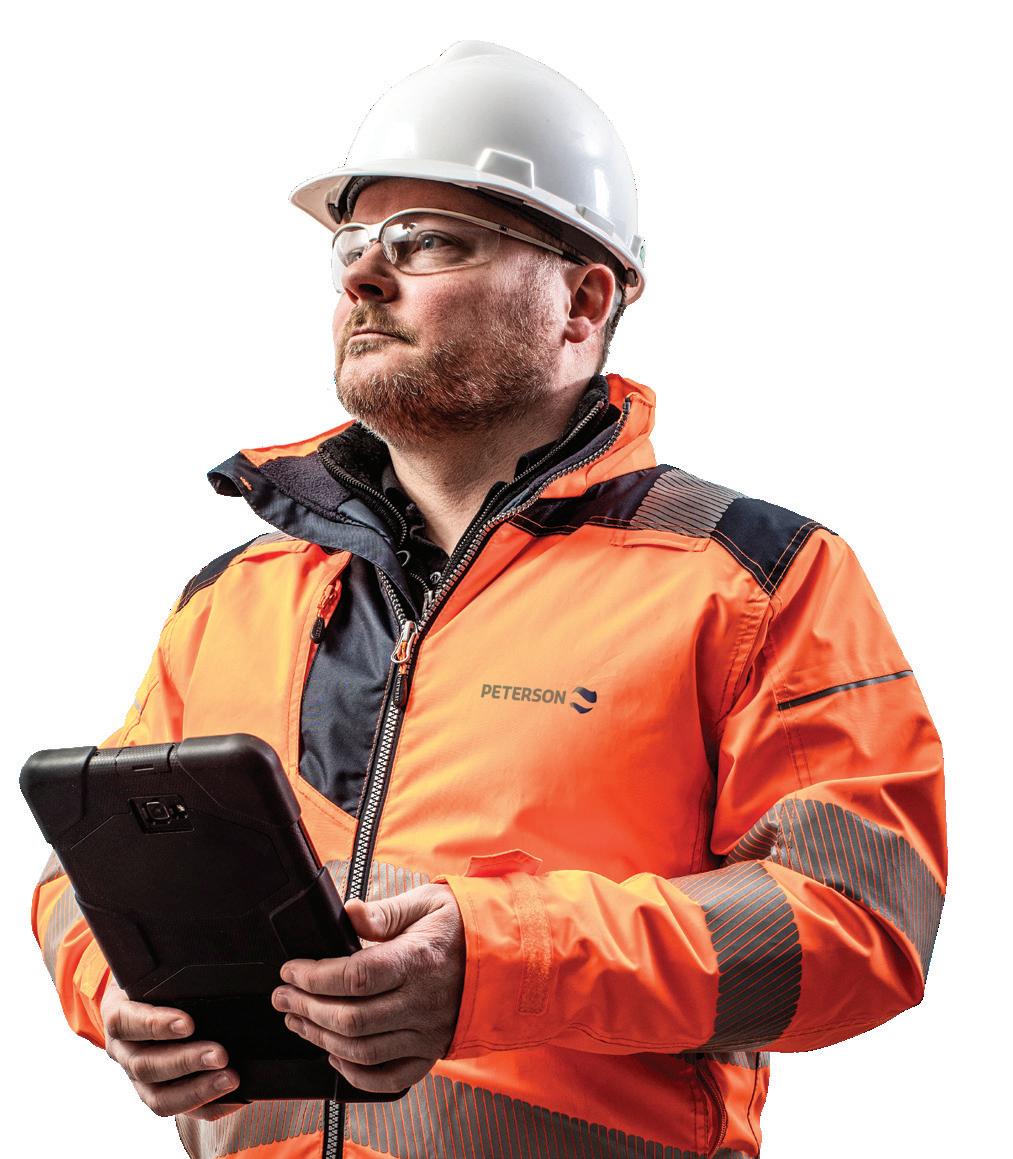
Think you know Peterson?
Peterson. See change.
See
A recent YouGov poll revealed that Britons are becoming more positive towards nuclear energy, with net support up 21 points since summer 2021. The discussion around how the country can boost its energy security is one reason for the rise, but people are also waking up to nuclear’s socioeconomic benefits. This year’s Jobs Map shows just how important the industry is to skills and employment.
Compiled annually by the NIA, the Jobs Map is a breakdown of who is employed by the UK nuclear industry and where. It is an essential visual tool, used to track which parts of the country are home to a nuclear workforce. 2022 didn’t disappoint. 64,509 people currently employed in the civil nuclear sector, the highest number in five years, and an increase of over 3,000 compared with 2021.
The industry is a vital engine of economic development, particularly in the North West, which remains the epicentre of the industry with over 25,000 people employed. From Copeland to Warrington it is the home of a world-class skills base in decommissioning and fuel. The South West is next with over 15,000 jobs, fuelled by Hinkley Point C, Europe’s largest construction project, which recently trained its 1,000th apprentice. A Hinkley-replica at Sizewell could provide a big boost for numbers in the South East too, which is currently at over 8,000 workers.
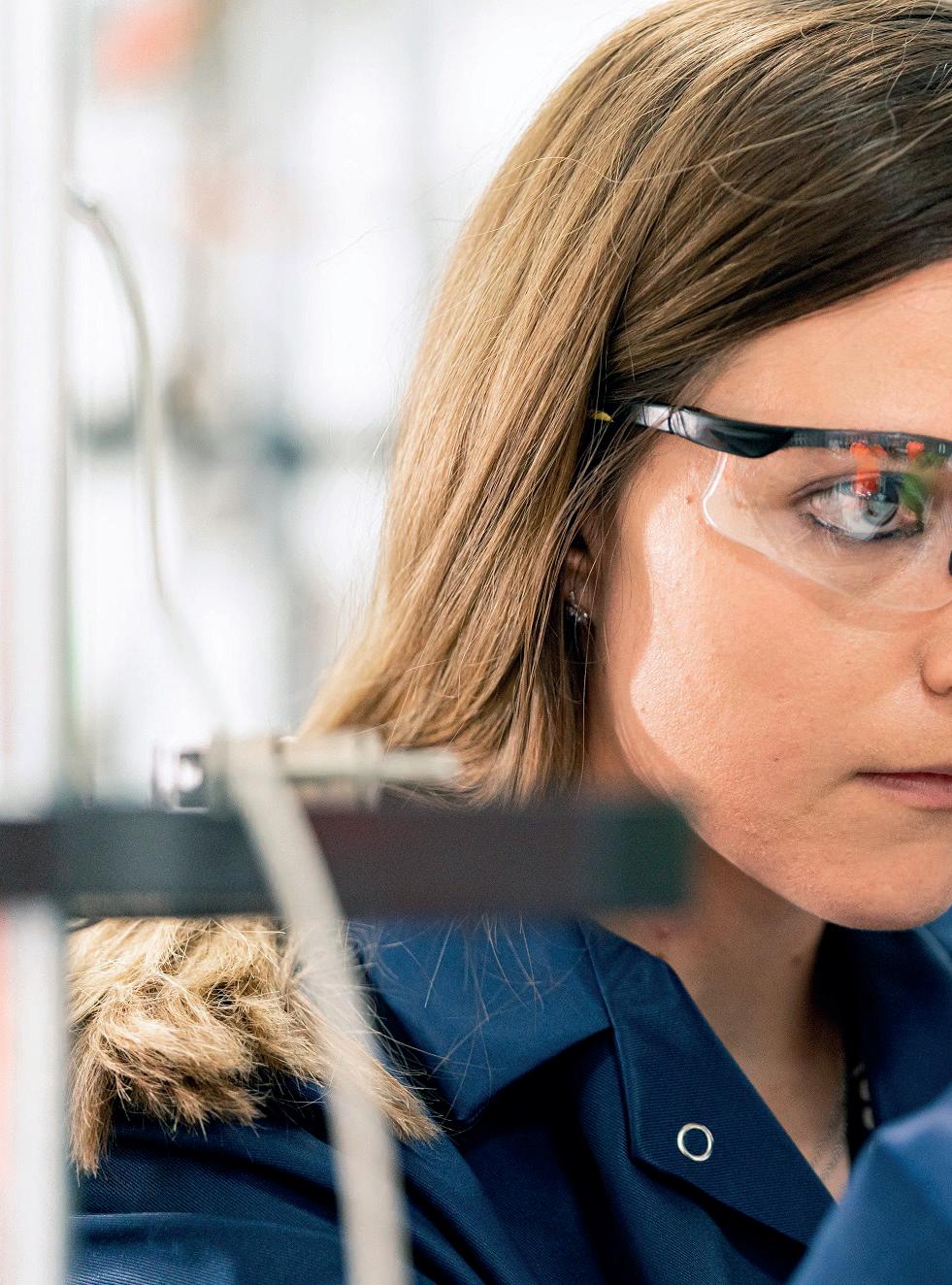
These numbers reflect the healthy state of the sector, with advancements happening in all corners of the industry, from SMRs to fusion, from decommissioning to GW scale plants, although there is work to be done to keep things on an upward trajectory. Urgent investment is needed to ensure national critical skills are not lost, particularly as the existing fleet retires.
Numbers don’t lie, and this year’s Jobs Map is a testament of where we are and where we are going as an industry. You can access the Jobs Map online at www.niauk.org/nia-jobs-map-2022 and we urge you share as far and wide as possible!
14 — WINTER | 2022
Jobs Map 2022: More people working in civil nuclear than at any time in the past five years
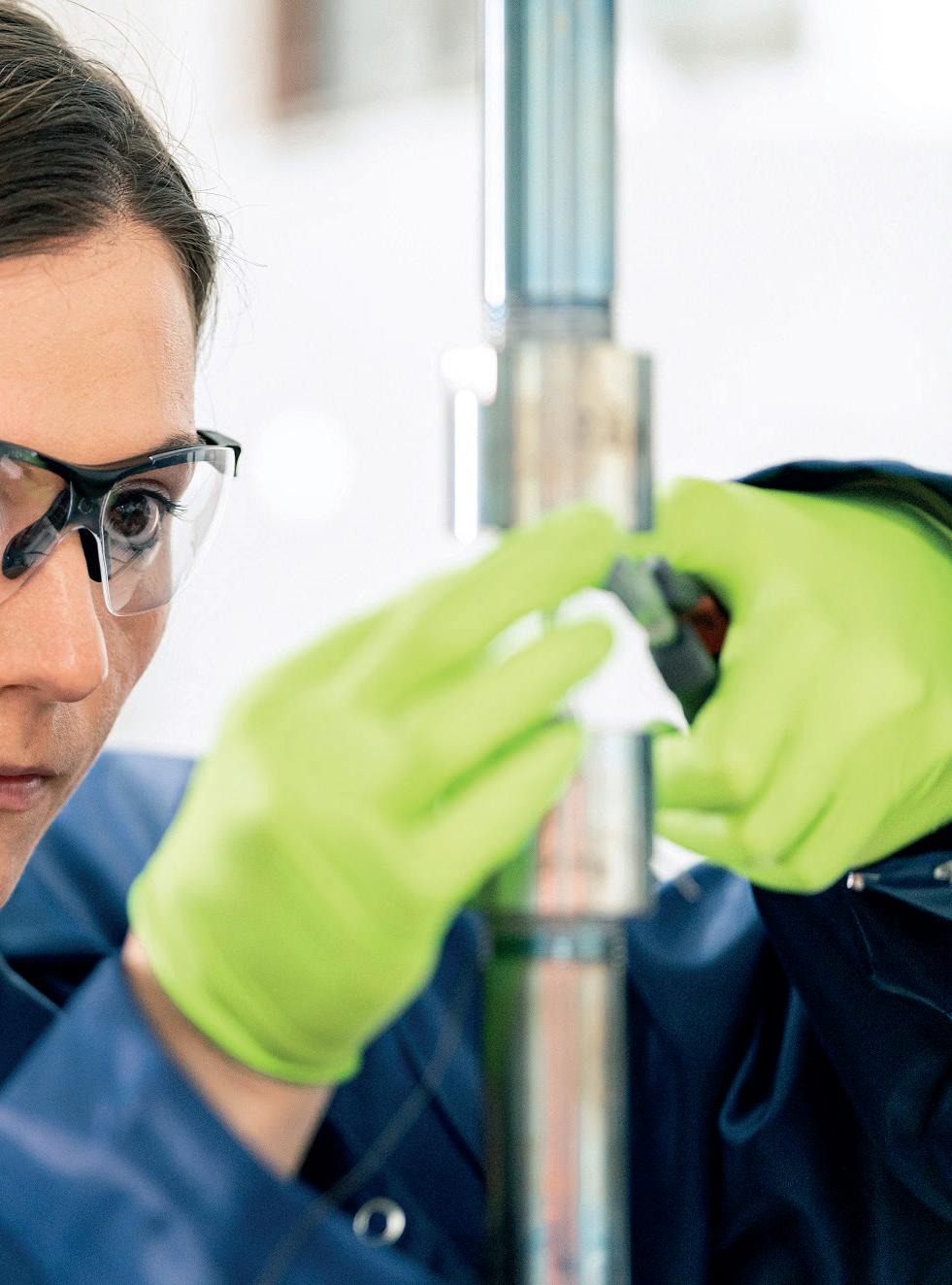
2022 | WINTER — 15

16 — WINTER | 2022
John Hurst BEng (Hons) Mech Eng., MIMechE
International
John is Chief Technical Officer for Safety and Assurance at DBD International and has specialist knowledge in Safety Case Development.
He brings to bear some 35 years of experience in the Nuclear Industry having worked for UKAEA, Sellafield Ltd (BNFL) and Atkins as Chief Nuclear Safety Engineer before joining DBD.
When John reflects on his career path and the journey he has taken to reach his current position, a key point he would make is that “When I was younger I did not have a clearly defined route to an end goal, and I realise now it is OK to be in that position. It’s OK not to know and to be conscious of the choice we have to make changes, and to choose different paths and realise that there is freedom and much to learn from failure.”
As an apprentice John always had an aspiration to learn and was academically minded. Yet he would say it was his enthusiasm and curiosity which ultimately led him to a career in nuclear after being offered the chance to work as an Assistant Scientific Officer for UKAEA while studying part time for a Mechanical Engineering degree. He speaks passionately about his view of the sector and his experience that nuclear can be a divisive topic which invariably leads either to being in a position of informing/educating people about it or defending it!
He says “I have always found nuclear to be such a fascinating subject and that my thirst for knowledge and experiences has never been quenched over the years, particularly because of the wonderful people I’ve had the privilege to work with.”
With the world at large staggering on, people and economies struck by the multiple blows of the financial crisis followed swiftly by the Covid pandemic, the ongoing war in Ukraine, the cost of living and energy crisis and the generally uncertain times within the UK there is much to bear. Yet it is the gift of humankind to prevail and the intrinsic nature of the British people to “keep calm and carry on”.
This is something that John is particularly passionate about. He talks about challenges without
borders, one of which is the availability of energy for everyone. “Future generations will judge us on how we each play a part in overcoming these challenges. I feel privileged to be a part of that as we look to strengthen the energy security of the UK through embracing nuclear as an essential part of the energy mix, in addition to it playing a key role in the goal of achieving Net Zero. This is our opportunity and I truly believe that the industry’s finest days are still to come in overcoming these societal challenges.”
John feels strongly that the nuclear sector needs to be an inclusive, diverse community where knowledge transfer is facilitated and encouraged. This desire to embrace new ways of thinking and working led him to DBD International where he is key to building an organisation that embraces challenge.
“I feel proud to work for an organisation that celebrates what it is to be different and we are, after all, unique. I am looking forward to continuing a career of problem solving and encouraging others to be ‘Different by Design’.”
So what are his hopes for the future of the sector? He cites nature as the best example to follow.
“For me collaboration and, as in nature, symbiotic relationships are essential. It is by coming together as human beings that we will succeed. There has been progress in the nuclear sector to work together for the greater good but there could be so much more. The sector is facing a known challenge of skilled resource shortage as people retire. It is imperative that knowledge transfer is facilitated and we all have a role to play in achieving that. Let’s not be precious about our wisdom which needs to be passed on for the benefit of the sector as a whole and generations to come.”
He sums up the conversation by reiterating his key message of embracing challenge and seeking meaningful relationships. “Every day is a school day and an opportunity to make another personal connection. Let’s not be frightened to challenge and be challenged, knowing that it is a privilege to work in this sector and share our knowledge and experience with each other.”
2022 | WINTER — 17
In a time of ongoing uncertainty and challenge, the importance of relationships and collaboration cannot be underestimated. John Hurst shares how his career path has been shaped and underlined by the human connections he has formed
Chief Technical Officer, DBD
The Power to be Safe
It is said that with great power, comes great responsibility. This couldn’t be truer for Ellie Bowsher, Osprey’s Quality, Health and Safety, and Environment (QHSE) Officer, working with the team that enables specialist logistics’ movements for Hinkley Point C. Every aspect of the role puts Ellie and the Osprey team at the heart of delivering nuclear success—enabling processes, empowering people to embrace continuous improvement through the delivery of critical assets.
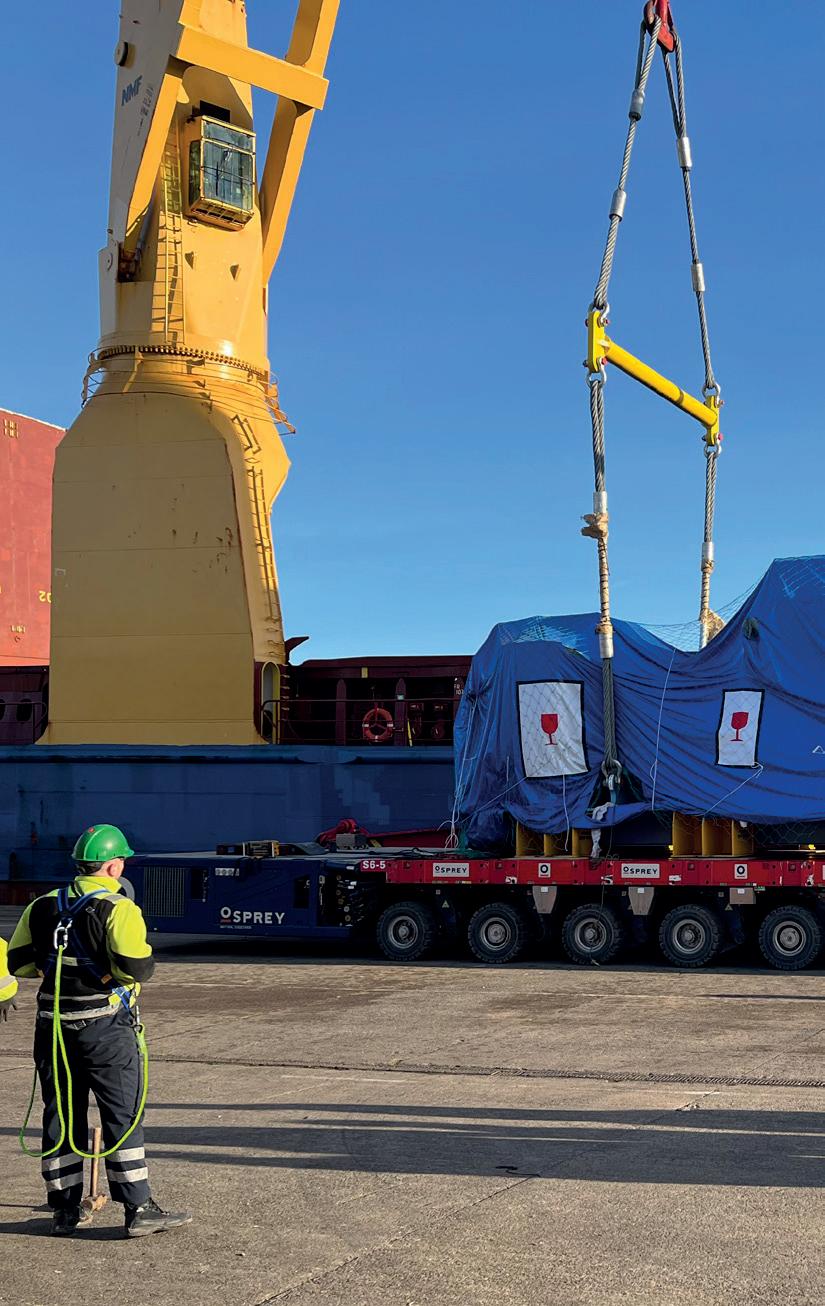
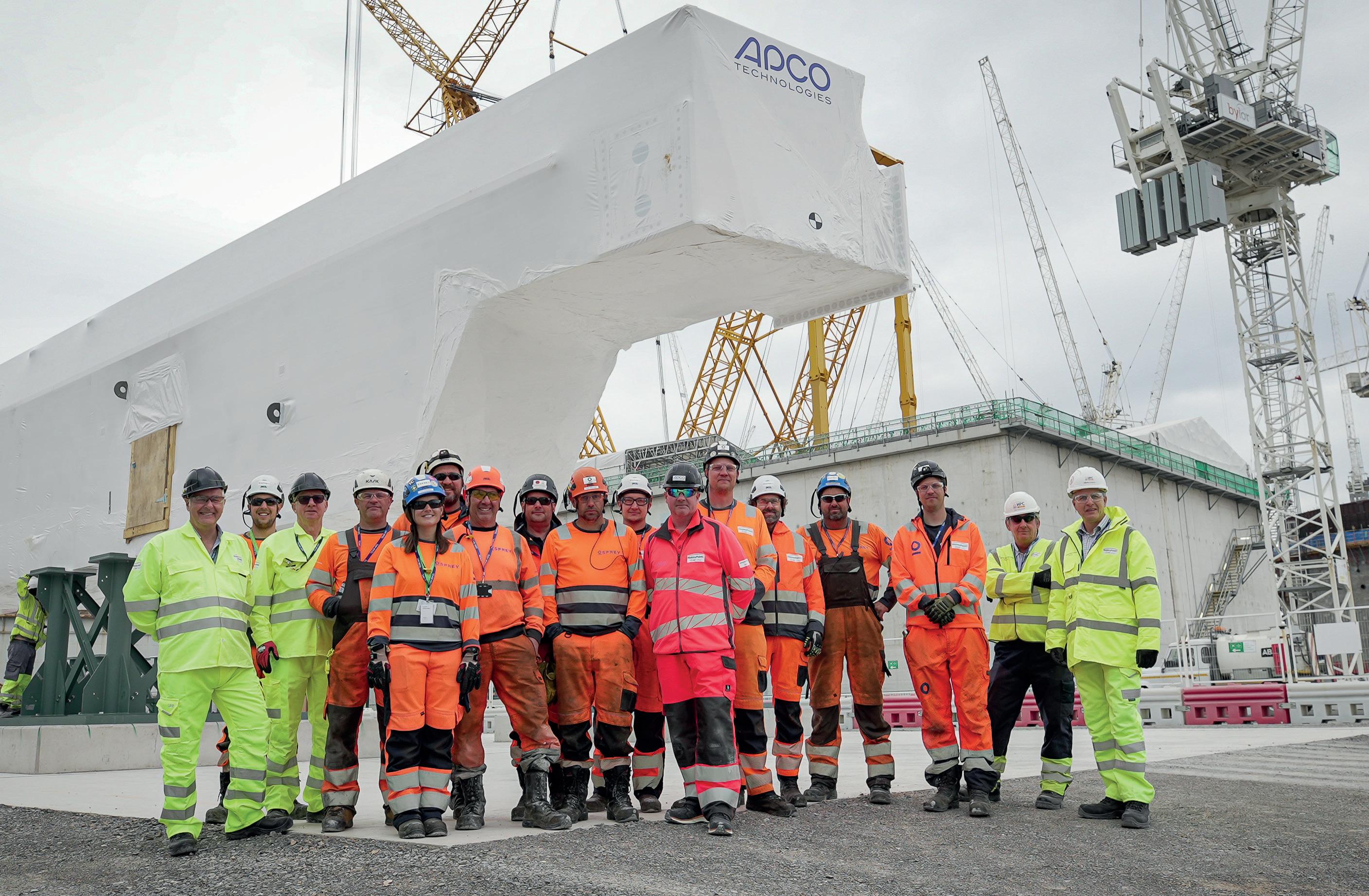
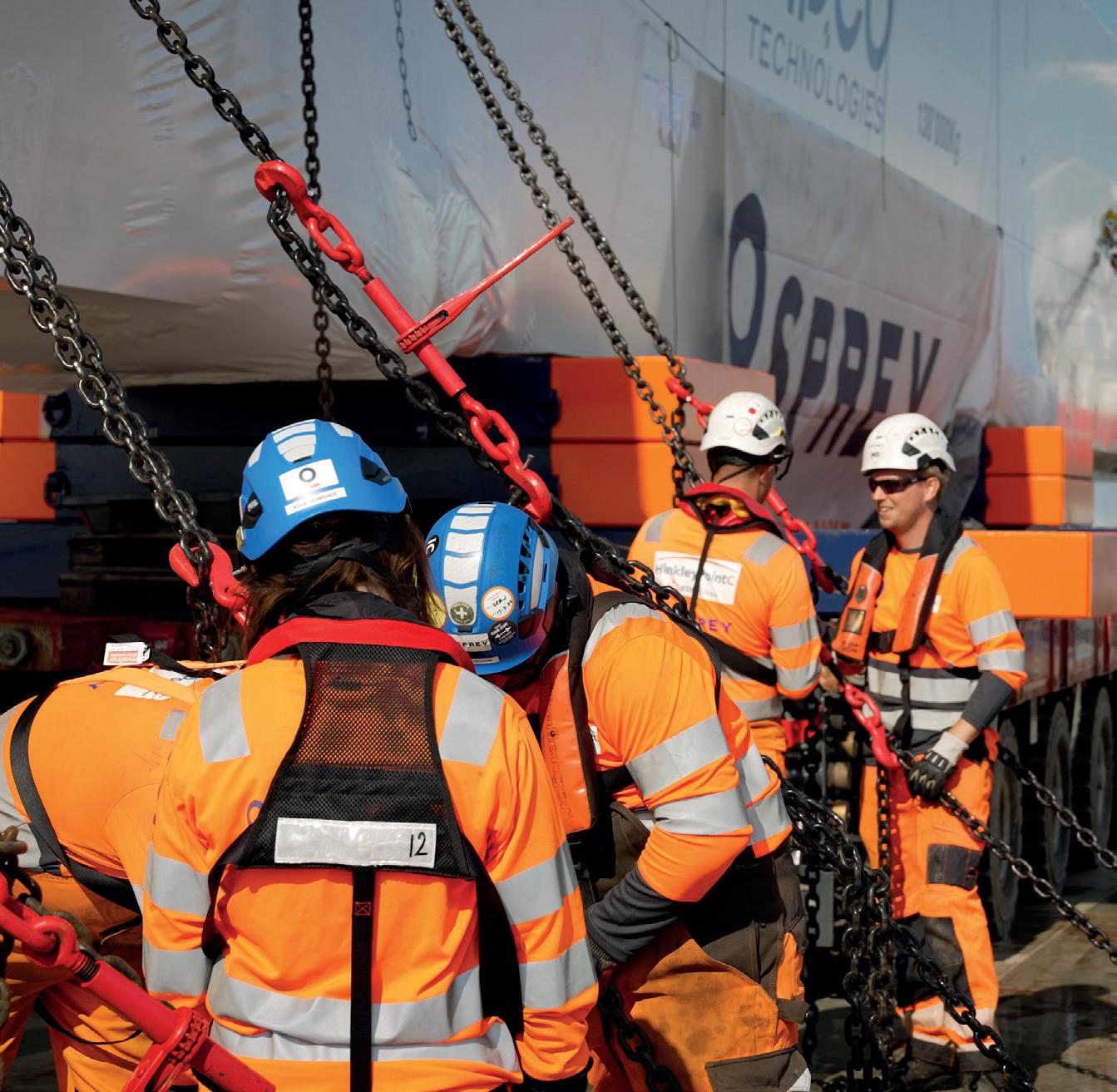
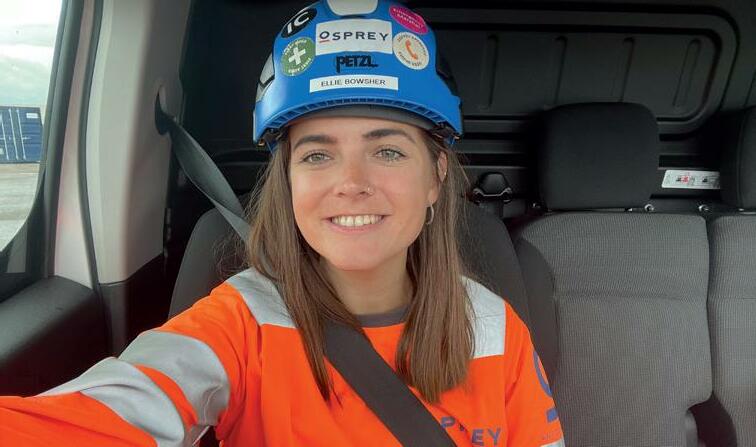
“Safety is a key consideration for me when putting together these solutions; I regularly discuss activities with the QHSE team to ensure we maintain our high standards and expectations. We work across a variety of locations which pose different risks, and I can rely on Ellie for assistance and support at all times.”
Ross Milne, Osprey’s Site Engineer, HPC
18 — WINTER | 2022 HELEN BATT • MARKETING MANAGER • OSPREY LTD
It is a behemoth. As a critical asset, the Polar Crane Electrical Girder Beam A is 44.77 metres long and weighs 138,000 kilos. It’s a milestone component that needs moving to site with the greatest of care, at less than 3 miles per hour on a specialist, four-file ten-axle self-propelled modular transporter (SPMT).
While it’s tempting to say the Polar Crane Beam is priceless, it is certainly pivotal to the function and safety of the nuclear reactor and it’s not something you can easily buy off the shelf if you need another one. It will service the reactor during every second of its operational life and, during the construction phase, it plays a crucial role in installing the Reactor Pressure Vessel and steam generators. Every millimetre of this asset’s movement has been reviewed off by Ellie Bowsher and the team.
Ellie explains the magnitude of the work here. “Manufacturers cannot send components this large overland to Hinkley. We have to bring them in via our Shared Services operation, which combines vessels, barges, cranes, SPMT’s—all kinds of transport coordinating multiple deliveries of oversized assets from their points of origin. Our work starts as soon as we know we’re involved with the assets’ movements, but here on the ground, my job begins the moment our teams take delivery—just a second.”
She is sitting in one of Osprey’s site escort vehicles, paying close attention to the smooth and orderly organisation of the specialist logistics going on around her. One of the contractors has stopped next to the vehicle to ask her opinion. She smiles and reassures him with an answer that speaks to bulletpoint order and months of pre-delivery preparation. “Where was I? Oh yes. This Polar Crane Beam is a good example to explain what I do here, what we all have to do on site for QHSE.”
As Osprey’s QHSE Officer for HPC, Ellie is part of the team that ensures every aspect of the operations take place safely. It’s a multi-faceted, complex job but the aim is simple. Putting safety first with zero harm, with minimum exposure to risk, and total dedication to continuously learning from every aspect of the operation. It’s a safety paradox that should be adopted industry-wide— looking for opportunities to improve standards, systems and procedures constantly. Not just meeting QHSE criteria but looking for better ways to deliver exceptional operations.
Complex, but simple
Ellie ticks off the many aspects of this operation’s QHSE role on her fingers: unloading vessels safely, monitoring the effectiveness of closed roads, detailing the transportation of assets into specialist storage facilities; making sure an incoming barge can unload onto specialist transport safely, lash down, and transit that load safely to its destination on time.
Dean Graham, Osprey’s QHSE Manager, provides some background to the project: “We’ve been working on the HPC project for the last 2 years; in this period our workload has expanded and the complexity of the projects we complete has increased which requires additional support and supervision in the world of QHSE. Ellie has slotted
straight into our team and has strengthened the high standards that we have at Osprey; this ensures we can carry out complex movements in an everchanging environment where managing risk is key to a safe operation.
“Pre-planning for all of those movements starts a long time before we’re here on site,” says Ellie. “There’s nothing about QHSE that’s not complex, but the aim is still simple. Safety first with zero harm—every job is done safely no matter how urgent it is—but I’ve said that, haven’t I.” She smiles. “It’s interesting, because everyone we work with here knows that and really does understand how important it is. I work with project managers and engineers, for example, to ensure all of the lifting plans and risk assessments will meet the high standards we have here at Osprey and HPC, which is a regulation-focused construction site, and they all know, QHSE has the first and final word on how things will operate.”
Watching the Polar Crane Beam move slowly but safely forwards, Ellie points at the four-file tenaxled self-propelled modular transporter on which the valuable asset is sitting. “We have plans that show every inch of this road in detail. There are all kinds of factors in play, road conditions, weather, it’s a case of always expect the unexpected, really. If there’s anything that causes us concern while it’s moving, I have to have the confidence to say ‘stop’ if I need to—knowing there are huge implications for everyone directly concerned, and indirectly affected too.”
Crucial to success
None of the operations happen without QHSE sign-off. It’s a team effort, but Ellie can stop all operations in a heartbeat. It is the QHSE team’s responsibility to be the catalyst for ever-improving standards. Translating actions, quickly, into working practices that embrace diversity and nurture an open ethos towards continuous improvement. In short, it’s Ellie’s job to ensure everyone and every aspect of critical asset movement is safe.
“It’s a fact,” she says, her eyes still on the trailer, “that the nuclear industry—nuclear construction and engineering—is male dominated, and I know there are targets to increase gender diversity in the industry. But here on the ground, my gender simply doesn’t play a role in ensuring high quality operations. That’s as it should be.”
The government commits to having 40% women in the civil nuclear sector by 2030, and Ellie acknowledges this as she goes on, “Women who want to come into this kind of work may find it’s a challenging role, I can’t deny that. But that’s not because you’re female, it’s because it’s varied, and technical, and constantly testing you to find better and better ways of working. The other side to this, is that I don’t feel like ‘a woman in nuclear’, and that’s a good thing. With the right team around you, gender just isn’t an issue.
“The industry bodies and organisations that I work with deserve recognition for that. It’s a milestone. It’s not a 9 to 5 job. But the important point here, is I feel safe. From stays in hotels, to running
2022 | WINTER — 19
operations on tidal times, to working in the middle of the night as part of a team that, yes, is maledominated, we can’t avoid that, I always feel safe. The culture has moved on, and the culture is now focussed on everyone being able to do the best job possible.”
Every stakeholder in these operations looks to QHSE as the guiding force that enables the successful and safe completion of a move like this. It’s Ellie’s responsibility to factor in a sense-check on every aspect of risk to their plans. “Things like access to emergency exits and equipment, ground trip hazards, inclement weather, tie-down methods, fatigue. All of those things are a risk, and they have a cumulative impact on people, equipment, and processes.” This has to be balanced against the constant pressure of a cost-per-minute delay to any movement. “Nobody takes health and safety for granted. But the central point of responsibility makes it manageable, and it makes it a continuous learning process too, which I enjoy.”
“We plan for the best possible movement by organising every aspect of it in detail, but we’re actually looking for ways to improve our approach all of the time. We have a ‘Toolbox Talk’ before each phase of the movement starts, during which we talk through the known key hazards; the different risks; what we need to be aware of in our plans and how the moment in time may be affecting those arrangements.
“Weather, for example, is a huge variable in what we do in QHSE. But then, we also run a ‘lessons learnt’ and ‘project lookback’ session afterwards, where my job is to ensure everyone’s voice is valued and heard, and all of the observations are gathered and evaluated for the next movement, and the one after that, and the one after that.
“It’s not just my eyes on site, it’s everyone’s responsibility to prioritise safety” Ellie is frank: “My job is to ensure QHSE is spot on. That’s it. So we ask what went well, what can we do better?
How can we improve on what we just did, and which things we’d like to change. It’s a continual loop of learning. We’re proud of it.”
Continuous improvement
Ellie recaps and emphasises: “The continuous improvement approach makes sense. It has to, as we’re all focussed on ways to work smarter and safer, which, eventually, will bring down the costs of construction and benefit us all. Like many of our clients though, HPC prioritises the highest standards. This is a very regulated environment, with good reason. But while those standards guide us in everything we do, we are also open to change—to improvement, which we can then share.
“As an example, we follow the industry standards for working at height but in our experience, that’s not enough. So we work at a better standard than that. The same applies when we see ways to improve lashings, or movements across a site, or a heavy lift, or any part of our operation really.”
In this respect, Ellie’s role extends beyond the scope of critical asset transportation. “QHSE affects all aspects of what we do. When we built a temporary habitat at Avonmouth around the EDG Gensets, for example, because they needed to be at a specific humidity and temperature, QHSE considerations were at the heart of that construction. Every part of it. Everything, from being the principal contractor working under CDM Regulations, inducting the construction teams that were coming on site to build it, to ensuring the emergency exits for the habitat itself were put in the optimum position.
“Risk assessments, method statements, scheduling —there isn’t a single part of an operation here that doesn’t benefit from our team’s non-stop focus on QHSE. That’s my job. I love it.”
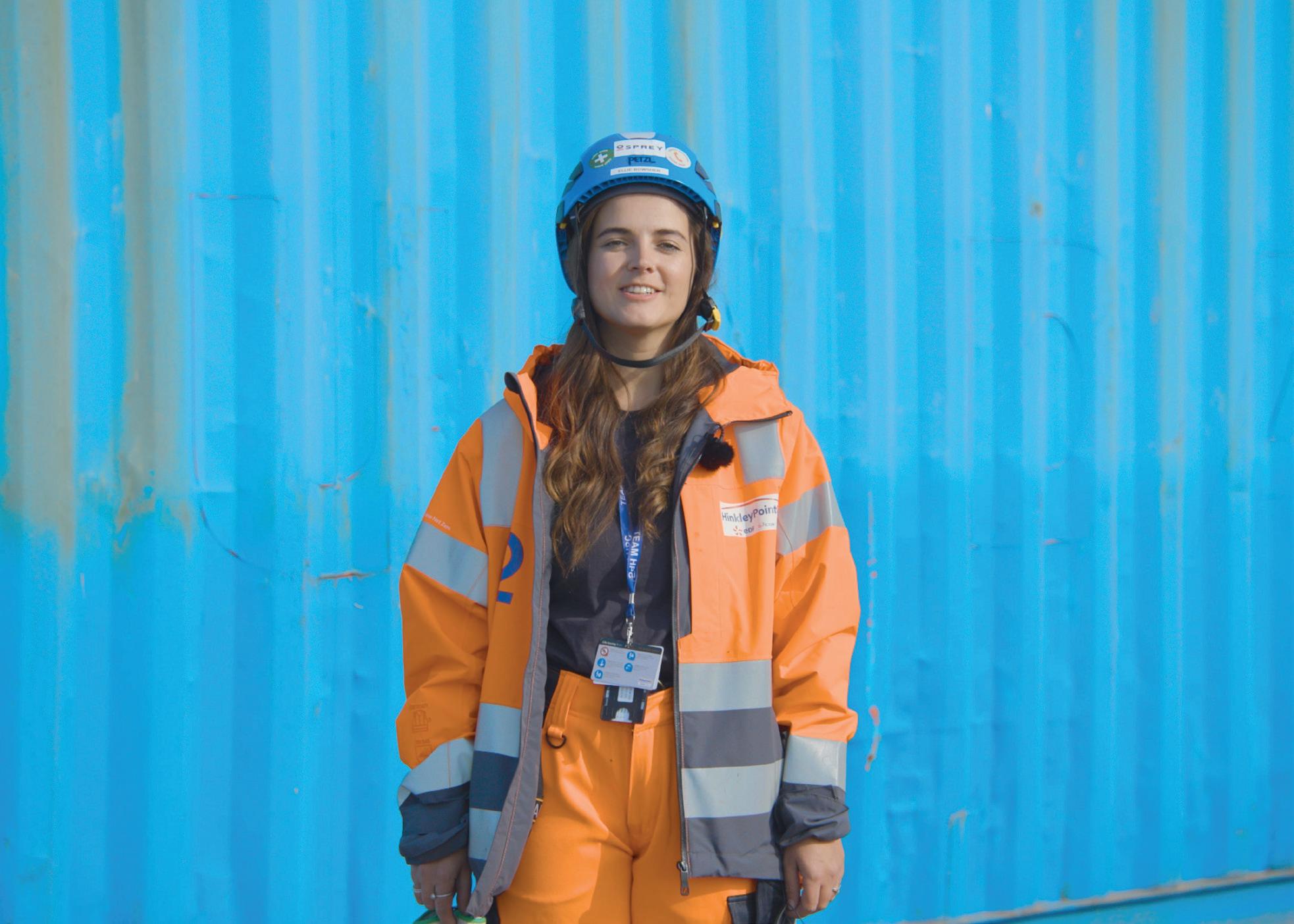
20 — WINTER | 2022
Cross Sector Learning In Decommissioning


On a surprisingly sunny October day in Aberdeen, decommissioning experts from the nuclear sector met with their oil and gas counterparts to share learning and knowledge and ultimately enhance collaboration between the two industries.

The day began by outlining the plethora of bene fits of cross-industry collaboration and introducing digital fluidity to the energy sector with engaging presentations from the Nuclear Decommissioning Authority’s Heather Barton and Dave Clark.
Collaborative opportunities regarding metal recycling were highlighted in a presentation from Zero Waste Scotland, before Sam Long, Interim CEO of DECOM North Sea, identified potential barriers to cross-sector collaboration. The morning session closed with a supply chain perspective from Load Monitoring Systems’ Kirk Anderson.
Lunch was followed by an introduction to decommissioning at Dounreay Restoration Site Ltd (DSRL) and a panel discussion with Iain Darby and Mark Rouse, joined by Nick Tulip from EnQuest—an oil and gas company embarking on an ambitious decommissioning journey in the North Sea.
The panel touched on preparing the workforce for larger operating envelopes, creating real collaboration
opportunities and the importance of learning capture for the future. We then heard from Sellafield’s Dr Mel Willis on exploring the implementation artificial intelligence to meet their challenges. Finally, a series of speakers discussed leveraging the strengths of Academia, Business and Industry towards decommis sioning before it was time to wrap up and close.
However, the event did not end with the presentations as delegates were offered a guided tour of the National Decommissioning Centre, where they were able to witness some of the state-of-theart equipment being developed there, including their decommissioning simulator.
All in all, this was a brilliant event which really highlighted the synergies of the two industries. Despite how unique and complex nuclear decommissioning is, the oil and gas sector faces many similar challenges. By working collaboratively, we can overcome many of these challenges in a more efficient and effective way.
As always, we are incredibly grateful to all those who helped us to organise this fantastic event: The NDA, DSRL and DECOM North Sea; and of course, our incredible speakers. If you missed out on the event, don’t worry, we have plenty more coming up. We hope to see you at the next one!
2022 | WINTER — 21 T 033 3939 0022 E sales@radiocoms.co.uk www.radiocoms.co.uk Let’s work together. Bringing your team closer together
devices and software to keep your team connected, safe and efficient regardless of their location. JAKE MOORMAN • ENERGY COMMUNICATIONS EXECUTIVE • NIA
Communication
Capula - Driving Digital Transformation Across the Nuclear Industry
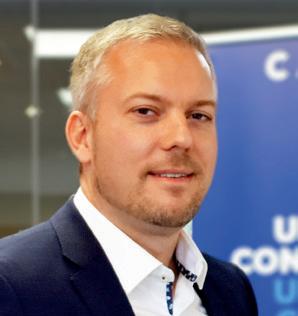
In these challenging and uncertain times: climate change, rising energy costs, financial instability and the uncertainty of the geopolitical landscape, the energy we use and the security around this has become ever more important.
To meet Paris Agreement targets aiming to limit increase in global temperatures to less than 1.5°c, world wide energy use must transition to cleaner and more sustainable energy sources.
Nuclear power is the most reliable, low-carbon energy source currently available to the UK and the country is already constructing the first of a new generation of nuclear plants, including Hinkley Point C, combined with strong support for a programme of new reactors, whilst extending the lifespan of a number of existing plants.
For over 50 years, Capula, part of the wider EDF Group, has been delivering full life cycle support to the nuclear industry as a leading industrial automation and control systems integrator for digital solutions and services, with over 240 trained and competent nuclear engineers.
With decades of experience delivering technology agnostic digital solutions for the UK’s nuclear energy infrastructure, Capula supports the evolving nuclear sector as it transitions to and plays a central role in enabling net zero.
Digitalisation has an extremely important role to play across the nuclear lifecycle including delivering the next generation of nuclear power plants, extending the life of current nuclear assets, or providing support to nuclear waste management and decommissioning. Digitalisation can provide significant advantages in the form of increased reliability and efficiency, combined with the reduction of risk.
At Capula we support nuclear clients going through transition by using digitalisation to enable them to create resilience, improve their planning, enhance implementation, and raise effectiveness.
Importantly this digitalisation links the more traditional control systems with the ability to combine data from many different sources, enabling information to be contextualised in a business sense and to be understood by all.

Take, for example, PLC, SCADA and Telemetry systems which traditionally have played a key role in daily operations for customers within the nuclear space. These systems provide firsthand, real-time access to discrete process and plant information, enabling operational staff to perform efficiently and safely. But this information is very often siloed with many different automation systems working across multiple sites and accessed only by certain individuals. As such, providing data relevant to specific sites but not the business as a whole. Combine this with data that is engineering biased, and it becomes very difficult to translate this into a business context.
Moreso than ever, businesses are now embracing how valuable operational data is to their long-term success and the part it plays in maximizing profits, driving efficiency and being one step ahead of the competition. This is especially the case if that data can be contextualized with additional data sources—for example third party data systems such as weather, or IT related information, coming from or going to SAP or work asset management systems.
Digitalisation ties all this together. It enables customers to seamlessly combine data from many different sources (IT, OT and Third Parties), breaks down the barriers between the IT and OT worlds
22 — WINTER | 2022
KRIS BRADSHAW • SALES & MARKETING DIRECTOR • CAPULA
“WITH DECADES OF EXPERIENCE DELIVERING TECHNOLOGY AGNOSTIC DIGITAL SOLUTIONS FOR THE UK’S NUCLEAR ENERGY INFRASTRUCTURE, CAPULA SUPPORTS THE EVOLVING NUCLEAR

SECTOR AS IT TRANSITIONS TO AND PLAYS A CENTRAL ROLE IN ENABLING NET ZERO.”
and, most importantly, enables the data to be contextualised in a business sense, enabling quick, real-time informed decisions to be taken, not only at plant level but operation wide.
By contextualising engineering data into business information, it can be understood by all. Couple this with an additional layer of analysis, and companies are then able to predict future events, for example, market trends, maintenance routines, regulatory compliance thresholds and operational plant differences. This additional layer of information can prove invaluable to businesses in driving operational change, reducing costs and becoming more competitive.
Capula is already working with many nuclear clients using a combination of tools to resolve business issues and challenges including:
● Predictive analytics—gathering data from nuclear power plants and analysing this to enable smart decisions including allowing for pre-failure maintenance
● Obtaining real-time operational status of plant and equipment to enable early notification of issues
● Predicting the risk of adverse events using historical data to identify cause and ensure prevention
● Increasing visibility and making sure all relevant parts of an organisation have access to information including assets, plant and operational performance across every business layer, taking this data and using it to enhance operational efficiency, reduce costs, eliminate downtime, enhance decision making and improve safety
● Simulation and digital twin technology modelling designed to prove system use prior to investment and integration and to accelerate programmes.
Digitalisation is enabling the nuclear industry to increase efficiency and quality, cut unplanned downtime, reduce costs, improve reliability of equipment and improve safety. It is helping to move to new ways of working that focus on achieving outcomes and actions influenced by insights from trusted data that combines OT time-series data with IT engineering data in a way that provide the contextualisation for models and dashboards.
The nuclear industry (whether in new construction, extending the life of fleet, fuel management or decommissioning) needs new ways of working and this can be achieved through digitalisation.
Capula is helping support this transformation of the nuclear sector through the application of innovative digitalisation. Across the nuclear industry—and many of its key projects—we have managed change programmes in an effective way, increasing efficiency and operational performance utilising the latest technology and building on our foundation of over 50 years operational experience and practice.
To find out how Capula can work with you to support your next generation nuclear power plants, extend the life of current nuclear assets, or provide support to your decommissioning environments, more information can be found at www.capula.com
2022 | WINTER — 23
▲ Image by Gerd Altmann from Pixabay — https://pixabay.com/illustrations/digitization-transformation-binary-5140071
NDA Stakeholder Summit
Around 200 stakeholders learned of the progress being made in decommissioning and cleaning-up the UK’s earliest nuclear sites.
The annual event, which welcomed representatives from the communities around the NDA’s 17 sites, saw two days of discussion and debate focusing on the re-structuring and progress of the NDA group.
NDA Chief Executive David Peattie welcomed MSP Mairi McAllan, the Scottish Minister for Environment, to make the keynote address on the first day of the Summit, the first-ever to be held in Scotland.
Scottish Context
Ms McAllan thanked the NDA group for its work in supporting its communi ties and the environment in Scotland, and paid tribute to Scotland’s nuclear engineering heritage, in what was seen as a strongly supportive speech.
She said: “The Scottish Government is committed to the safe, secure and responsible clean-up of nuclear sites, with care for people and the environment. Partnership working and engagement are critical to the successful management of Scotland’s nuclear legacy.
“I’m grateful for the close working relationship the Scottish Government has with the NDA as well as the range of other organisations and communi ties associated with nuclear sites in our region. I am especially aware of the contribution decommissioning work continues to make to local communi ties and economies around our sites in Scotland.”
One NDA landscape
Presentations on the first day of the Summit focused on the NDA’s new group operating framework. Based on four pillars of Sellafield Ltd, Magnox, Nuclear Waste Services and Nuclear Transport Services, delegates were brought up to speed on how the NDA group philosophy is expanding and evolving.
The audience included community representatives from all 17 of the NDA group’s sites, along with local authority members, regulators, opposition groups and NGOs, and representatives from BEIS and the devolved administrations, with good attendance from Scottish and Welsh officials.
Executives from the four operating companies within the NDA group gave their own updates from their business perspective, and the event also focused on NDA group Beacon Projects, highlighting the industryleading work in sustainability, social value, and skills that the NDA is known for throughout the nuclear industry.
Outreach and engagement
The Edinburgh Stakeholder Summit was the first time in three years the NDA could meet its key stakeholders in person. The previous two events had been virtual due to the constraints of the pandemic.
Via stakeholder feedback from Strategy 2021 and regular surveys, NDA was asked by stakeholders to broaden its engagement to include more outreach to young people around its sites, to increase its use of digital communications to reach a wider audience, to focus on national stakeholders as well as its host communities at sites, and to create a regular dialogue with opponents and NGOs, to allow greater inclusivity of viewpoints, and challenge.
The NDA’s commitment to stakeholder engagement in anchored in the Energy Act and strategy is co-created with stakeholders, with engagement a key enabler to delivering the NDA’s mission in its Strategy 2021—a five-year strategy which the NDA reports back on regularly to its stakeholders in a series of regular platforms.
The NDA/NGO Forum agreement was signed at the Summit and underpins the NDA’s commitment to openness and transparency, by encouraging wider scrutiny of NDA activities. This new Forum will meet
from November, and provide regular dialogue between the NDA leadership and regional and national NGOs.
Outreach programmes to young people, including an art/photography project based around a “Sense of Place”, and featuring internationally renowned industrial photographer Michael Collins, will tour NDA sites in 2023. His remarkable art photographs of NDA sites were exhibited at the Summit.
Social value and support for university research
NDA Chief Executive David Peattie used the Summit to announce £528,000 funding to support creation of three new Post-Doctoral Research Bursaries with the Universities of Strathclyde, Lancaster and Keele.
The bursaries will offer academic researchers, who have completed their PhDs, the opportunity to develop their research career in some of the NDA’s key focus areas of sustainability, the environment, engagement and the management of risk.
While providing the researchers an important career steppingstone, the bursaries will also allow the NDA to work with new academic talent and fresh thinking regarding the approach to mission delivery.
David Peattie, NDA group CEO, said: “I’m delighted to announce three new research bursaries in recognition of the contribution and difference individuals can make in our organisation.
“We hold research and learning very close to our hearts, evidenced by the fact we’ve invested £6.2 million supporting more than 50 postgraduate researchers across the UK in the last 5 years. Our work with academic institutions to support postgraduates with bursaries, is hugely important in progressing our mission and helping to create the subject matter experts we will need in the future to clean up our sites.”
The NDA’s next in-person Summit will be held in West Cumbria.
24 — WINTER | 2022
JOHN MCNAMARA • HEAD OF STAKEHOLDER ENGAGEMENT • NUCLEAR DECOMMISSIONING AUTHORITY
Leaders from the nuclear decommissioning industry spent two days in Edinburgh with national stakeholders at the 2022 NDA Stakeholder Summit.


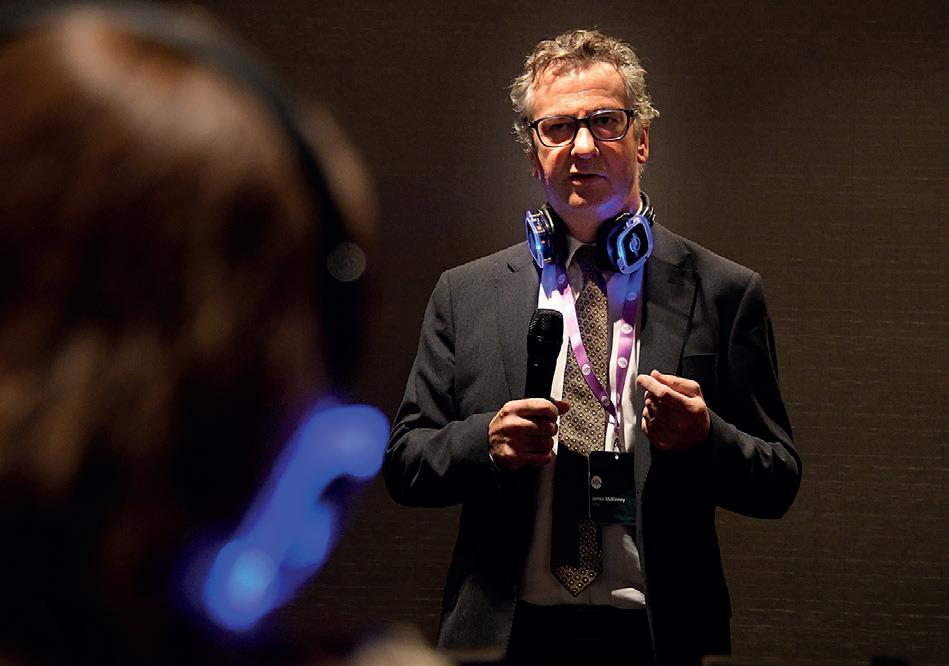
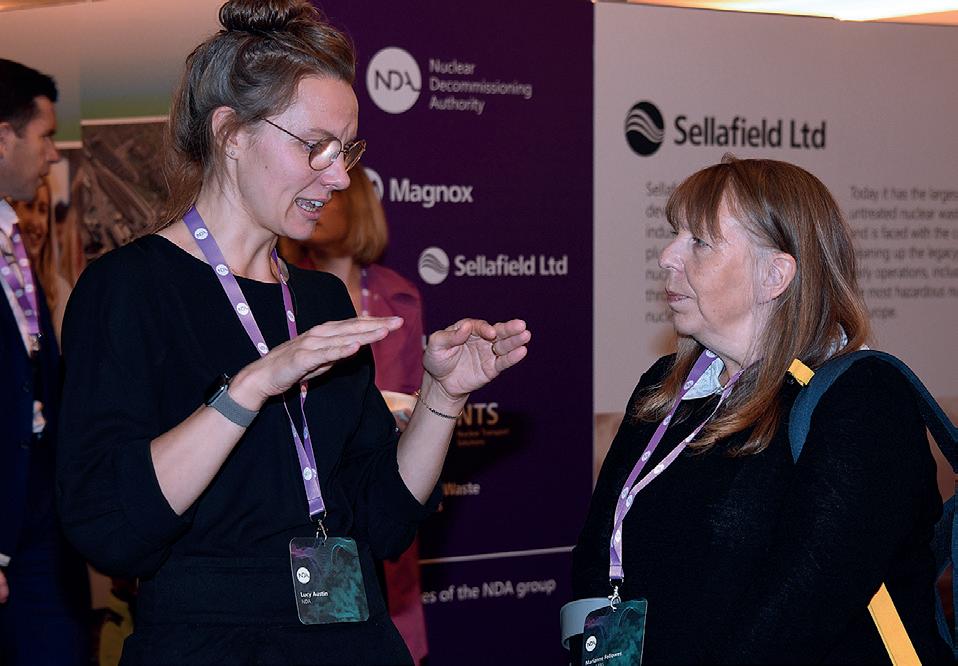
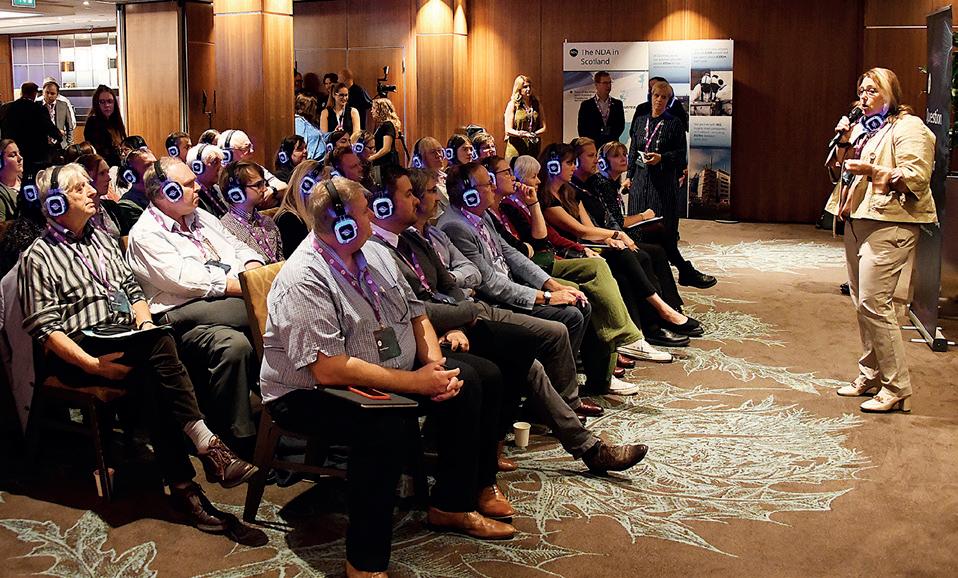
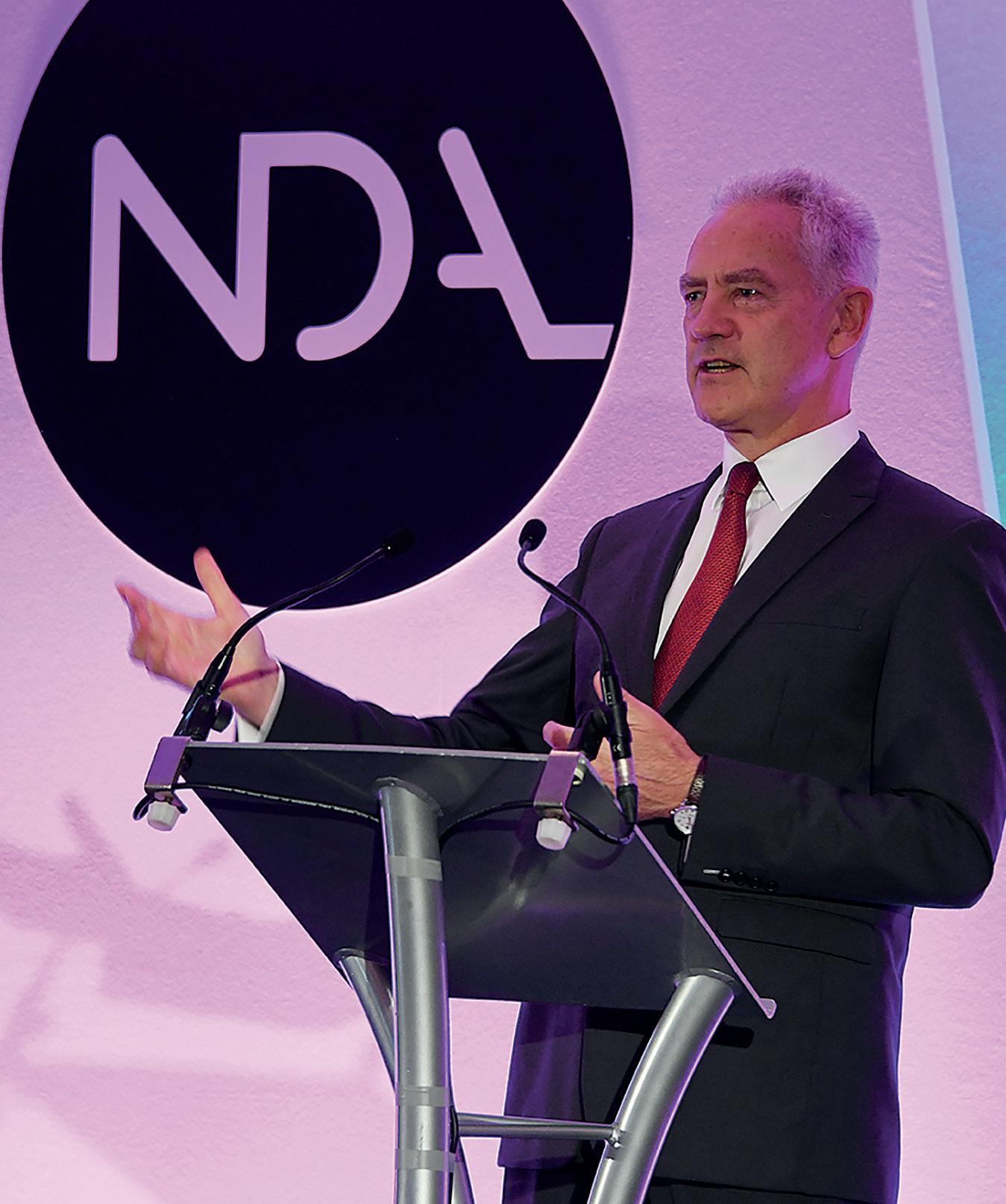
2022 | WINTER — 25 DBD 121mm x 155mm plus 3mm.indd 2 15/09/2022 16:58
Europe’s nuclear awakening
Don’t call the sudden change in European nuclear prospects this year a ‘Nuclear Renaissance’. The rapidly improving prospect for nuclear energy is driven not primarily by hype over new technologies, but rather by governments facing up to ever-more challenging climate targets and the grim realities of a war that has unmasked energy policy and market failures across the continent—writes David Hess, Policy Analyst at the World Nuclear Association.
A recent in-depth Al Jazeera piece suggested that no major nuclear ‘pivot’ is currently underway in Europe, noting that countries which have traditionally been opposed to the technology remain so, and that no newcomers have suddenly emerged. I think this is a reasonable assessment—for now—but it also downplays the importance of what has been an utterly extraordinary year for nuclear policy developments in the region. Examining these reveals a strong case for optimism.
It is easy to forget that, prior to February, the biggest battle facing the European nuclear sector was inclusion in the EU’s green finance taxonomy. Following a favourable verdict by scientific experts in June last year, the Commission finally revealed a draft Complementary Delegated Act on New Year’s Eve. This was then sent for scrutiny in March where Council backing was quickly secured. The ultimate fate of both nuclear energy and natural gas was left in the hands of the European Parliament.
Sensing vulnerability, activist groups launched an emotive campaign to influence MEPs. It seemed like the vote was in danger, but in the end it simply wasn’t. 328 MEPs voted in favour of including nuclear, while 278 voted against with 33 abstentions and 66 MEPs not taking part in the vote. The large margin by which the antis lost suggests something once unthinkable—that nuclear is beginning to lose its ‘controversial’ status.
The inclusion of nuclear in the EU taxonomy marks a clear victory for evidence-based policy making and offers a boost to nuclear prospects. While it does not singlehandedly solve the nuclear financing challenge it does provide confidence that the technology will
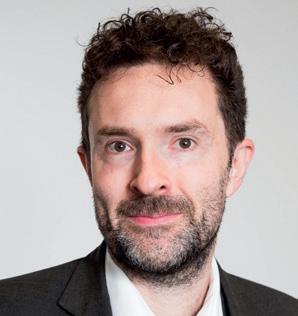
play a major role in the region’s energy transition and reduces obstacles for private investment. There will undoubtedly be future battles at the EU level, but nuclear energy should be more visible in EU climate and energy policies going forward.
The significance of the taxonomy has long since been overshadowed by Russia’s invasion of Ukraine. This exacerbated the ongoing natural gas crisis, sent energy prices sky-rocketing and elevated energy security right to the top of the European political agenda. Faced with this, many countries began to re-evaluate their existing nuclear energy plans.
Germany is the obvious example, with the country incrementally beginning to wind back its long-standing nuclear phase out. Its three operating reactors had been scheduled to close by the end of the year but in September the government gave permission for two units to be kept in reserve—ready to be brought online if necessary. However, on 18 October, Chancellor Scholz ruled that all three remaining reactors would be allowed to operate until April 2023, squeezing the remaining megawatt-hours out of their fuel.
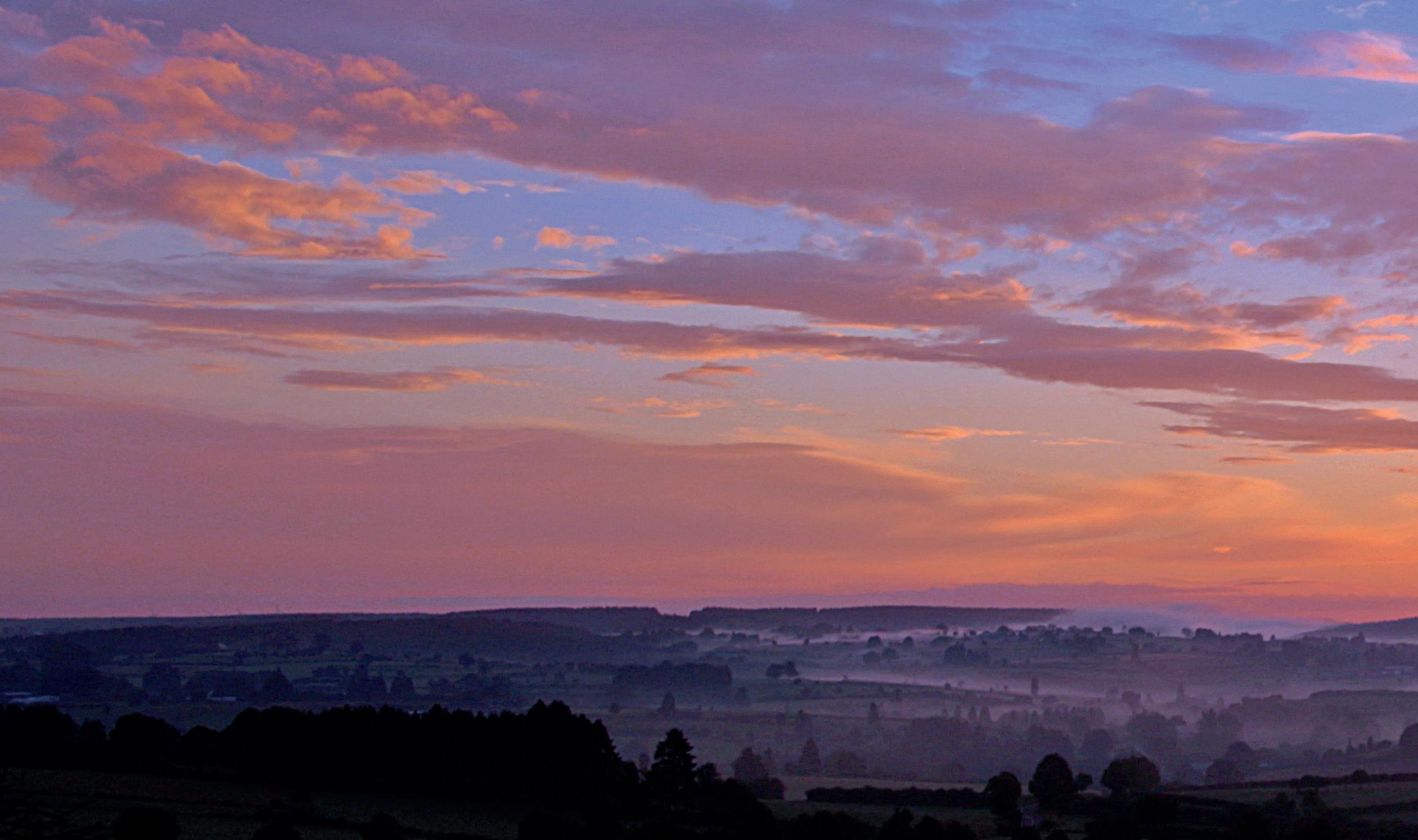
For now, the country remains committed to restarting coal plants and building LNG terminals, rather than prolonging or bringing back nuclear generation. This has rightfully attracted international criticism, with even climate activist Greta Thunberg calling Germany out on this. The debate is clearly still live and further changes to German nuclear policy may yet occur.
The other European country with a clear phase out trajectory, Belgium, recently pushed this back when the government announced that two units, Doel 4 and Tihange 3, would be allowed to operate for an additional ten years. Hopefully, talks remain ongoing about the country’s other units, although Doel 3 was retired in September as if there was no crisis on. Belgium’s pre-crisis plan was to shut down all nuclear plants and replace this with natural gas by 2025. This plan now look absurd.
On the new build side of things, the war and ongoing gas crisis seems to have catalysed several
26 — WINTER | 2022
DAVID HESS • POLICY ANALYST • WORLD NUCLEAR ASSOCIATION
▲ Image by Myriams-Fotos from Pixabay — https://pixabay.com/photos/sunrise-sun-dawn-morning-sky-1513802
countries into launching new build programmes or expanding upon existing ones.
The Netherlands, long ambivalent about new nuclear, earmarked 564 million USD for the earlystage development of two new units in December last year, as well as committing to keeping its sole plant at Borselle operating for longer.
Very recently, the new Swedish government has made clear its strong support for new nuclear, promising to make 36 billion USD worth of state guarantees available and instructing national utility Vattenfall to start planning for new build. Not wanting to be left out, Finnish utility Fortum has started a feasibility study looking at building new nuclear in Sweden and Finland.
Ukraine has long been preparing for new nuclear, but in July it announced that it was expanding plans from 5 new AP1000 units to 9. Unsurprisingly, it also vowed to end all Russian involvement in their nuclear fuel and supply chain.
While most developments following the start of the war have been undeniably positive for nuclear projects, not all have been. Finland moved quickly to censure Russia and the project-company Fennovoima ended up cancelling its contract with Rusatom Overseas for the construction of VVER units at Hanhikivi. For now, the project remains in limbo.
Other recent nuclear new build developments have little to do with the crisis but have clearly not been hindered by it. Most notably, France launched a major new build programme in February. Macron committed to building 6 new EPR 2s with an option to build another 8. He further committed to the long-term operation of all the remaining French nuclear plants.
Poland—Europe’s most advanced newcomer country—has just decided to partner with US company Westinghouse for the delivery of its first nuclear power plant. As of writing it appears the country has also signed an agreement with South Korea for the construction of further reactors.
Czechia launched its long-awaited tender for new nuclear at Dukovany in March. In what now seems like prescience, they excluded Russian participation from the tender process in April last year.
In 2021, Romania signed agreements with Canadian and US-companies to complete two partially-built CANDU units at Cernavoda, and this year contracts were signed for the refurbishment of an existing unit that will allow it to generate electricity until 2060.

Yet other European nuclear developments seem to be going ahead despite the invasion of Ukraine—with authorities in Hungary finally issuing a construction license for new Russia-built VVERs at Paks. News has also surfaced that Russia is considering constructing new reactors, possibly SMRs, in the Kaliningrad exclave which borders Lithuania and Poland.
Unrelated to the crisis but still significant, several long-running reactor construction projects came to an end this year with Olkiluoto 3 (Finland) achieving grid connection and Mochovce 3 (Slovakia) achieving initial criticality. Both projects will still have to overcome the inevitable commissioning hiccups but the timing for start-up could hardly be better as experts predict high gas prices to remain for several years.
And not to be forgotten, there is also clear progress and growing appetite for SMRs, with various agreements signed in Poland, Romania and Czechia for US designs, while both the UK and France are supporting domestic technology development. After Poland, the next European newcomer country to start building nuclear reactors looks likely to be Estonia, which plans to build only SMRs. This will be a global first.
Taken altogether, it appears that the nuclear sector in Europe has passed an inflection point. Nuclear new build is set for a revival, its prospects boosted by the new geopolitical reality and increasing public support. It may be too early to call this a nuclear renaissance, but momentum will surely build in coming years, spreading to nonnuclear countries which will otherwise increasingly find themselves dependent on the import of reliable electricity from their nuclear-powered neighbours.
And in any case, the current nuclear outlook does not feel as inspiring as a renaissance. Rather, it feels like awakening from a long hibernation to realise that there ‘s urgent business to be getting on with.
2022 | WINTER — 27
“It appears that the nuclear sector in Europe has passed an inflection point”
Milestone first
NEWS FROM THE HUB.
ductwork
delivery from KAEFER to Hinkley Point C
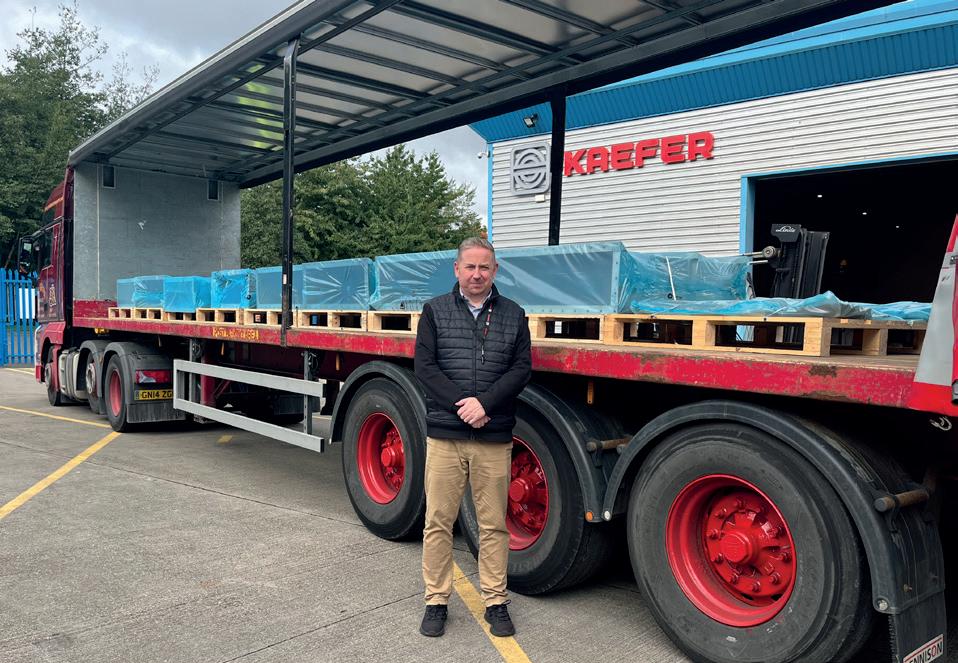
In early October the first delivery of precisionengineered, steel ductwork left the KAEFER Fabrication Facility in Jarrow, Tyne & Wear, headed for Hinkley Point C.
The specialist steel ductwork, manufactured to the highest quality standards for use in a nuclear environment, will be installed in the dome in reactor 1 at the Hinkley Point C site.
During the project KAEFER UK & Ireland will provide ductwork for the nuclear island for both units 1 and 2 at the Hinkley site. The early October delivery contains the first in a series of tens of thousands of ductwork pieces destined for the new nuclear power station from the Jarrow site over the next three years.
The facility in Jarrow became the KAEFER UK & Ireland Head Office in 2021, following the purchase of the Wood Group Industrial Services business by KAEFER in 2020. 60 head office administration staff are based at the site alongside the Fabrication Unit.
“The Hinkley Point C contract secured the future of our Fabrication facility at Jarrow. On top of the roles we protected, we’ve recruited an additional 30 highly skilled colleagues to join the business in 2022, and we’re not stopping there. We’re actively recruiting four trainees to start in December and want to recruit another four by the end of 2023. We have big plans for the KAEFER UK & Ireland business, and I’m delighted that the north-east can play such a pivotal role supporting growth in the nuclear power industry.”
Carl Roberts, General Manager at Jarrow site
GDF to
As well as supplying high grade steel ducting for the nuclear island at Hinkley Point C, industrial services specialist KAEFER is also responsible for delivering containment liner coatings, surface protection for concrete in the internal building rooms, and providing access solutions.
In mid-October KAEFER was announced as a finalist in the 2022 National Access and Scaffolding Confederation Project of the Year (Large) Awards for its work on the Nuclear Island Inner Containment Liner at Hinkley Point C. The project involved design ing, building, and installing a suspended scaffold for the liner, using a bespoke design minimizing the need to work at height. The innovative design allowed for critical path works on site to be replanned, allowing for early installation of the liner, a significant mile stone for the client.
than 4,000 jobs in first 25 years
More than 4,000 jobs are to be created during siting and constructing of a deep underground ground facility for the safe and secure disposal of higher-activity radioactive waste.
The Geological Disposal Facility Creating Jobs & Skills: A First Look report, published by Nuclear Waste Services (NWS), sets out how the multi-billion-pound programme is expected to create thousands of skilled, well-paid jobs for over a century.
This highly engineered facility will be one of the biggest infrastructure projects in the UK and will provide a major investment for the local host community and its economy. Work on a GDF will carry on for about 175 years, generating an expected average of 2,000 jobs in any given year. During this time, it could provide significant additional investment and create thousands of extra jobs through increased business opportunities and the development of new or improved infrastructure and facilities across the region.
Employment will be generated at the facility itself and in the supply chain, while attracting further investment in the local area. Most of the jobs created during construction and, operation could and should be locally based.
NWS will be the developer of a GDF and is committed to recruiting locally where possible, and once a site is selected, roles would be available in a range of disciplines including engineering, science and technical, trades, operations, and business functions.
The long timeframe means that education and training initiatives are planned to ensure local people have the best opportunities to develop relevant skills and qualifications. This project will provide a unique opportunity not only to recruit but also to upskill and reskill local communities, transforming the prospects of a region for generations.
The search for a suitable site is a process based on community consent and includes detailed investigations over a number of years to ensure a GDF can be constructed safely and securely. Community Partnerships, which have formed in Mid Copeland, South Copeland, and Allerdale in Cumbria, and Theddlethorpe in Lincolnshire, are engaging in a dialogue with local people to ensure they have access to information about what hosting a GDF might mean.
To learn more about GDF, please read the Report at shorturl.at/kxz19.
28 — WINTER | 2022
create more
KBR’s growing nuclear family
Over the last two years, KBR’s nuclear workforce has seen a rapid rise growing by 370%. In 2020, KBR had 182 people working on nuclear programmes across the UK, in 2021 this grew to 322 people and today stands at 855 people.
The rapid rise follows key acquisitions of Harmonic and Frazer Nash Consultancy, and a number of significant contract wins, which now sees KBR people working on some of the UK’s most exciting nuclear new build, defence and decommissioning programmes. One of these programmes is the game changing Programme and Project Partners (PPP) contract at Sellafield in north-west England. Over 300 people make up KBR’s team at Sellafield, working collaboratively with the partners to deliver a 20-year pipeline of major infrastructure projects that will enable the decommissioning and remediation of the site’s legacy facilities.
“We bring scale through our people, their knowledge and breadth of technical expertise. As a trusted partner to the nuclear sector our people are working across multiple nuclear projects around the UK, delivering technical, digital, and transformational expertise for our valued customers. What sets us apart is our approach, working as an integrated team with our delivery partners, providing innovative, technology-led solutions to solve our customers’ most complex challenges and to shape the future success of the nuclear industry. It’s really exciting to see how our diverse teams are delivering for our customers, and I can’t wait to see more of this in the future.”
Matt Jacobs, Vice President Projects & Programmes Division, KBR Government Solutions International
KBR recently added Nuclear Waste Services, like Sellafield Ltd a subsidiary of the Nuclear Decommissioning Authority (NDA), to its clients and is now providing expert project, programme and portfolio management for a future Geological Disposal Facility —supporting safe and sustainable waste disposal for legacy and future nuclear projects in the UK.
In addition to the growth in KBR’s workforce, the business is investing in internship, apprenticeship and graduate programmes, providing rewarding opportunities for those at the start of their careers.
What’s more, KBR became ‘Great Place to Work’ certified in 2022 proving the company to be one of the UK’s employers of choice for people who want to do work that matters. Search the latest career opportunities at KBR.com/careers.
Sellafield continued invesment in apprentices
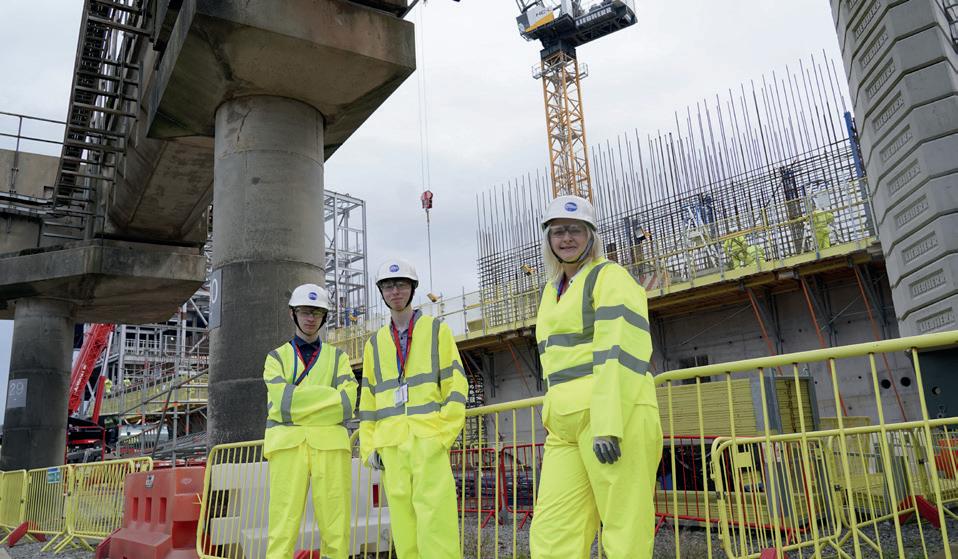
Almost three hundred young people started their nuclear career with Sellafield Ltd this month as the company welcomed the new cohorts of 200 apprentices and 88 graduates.
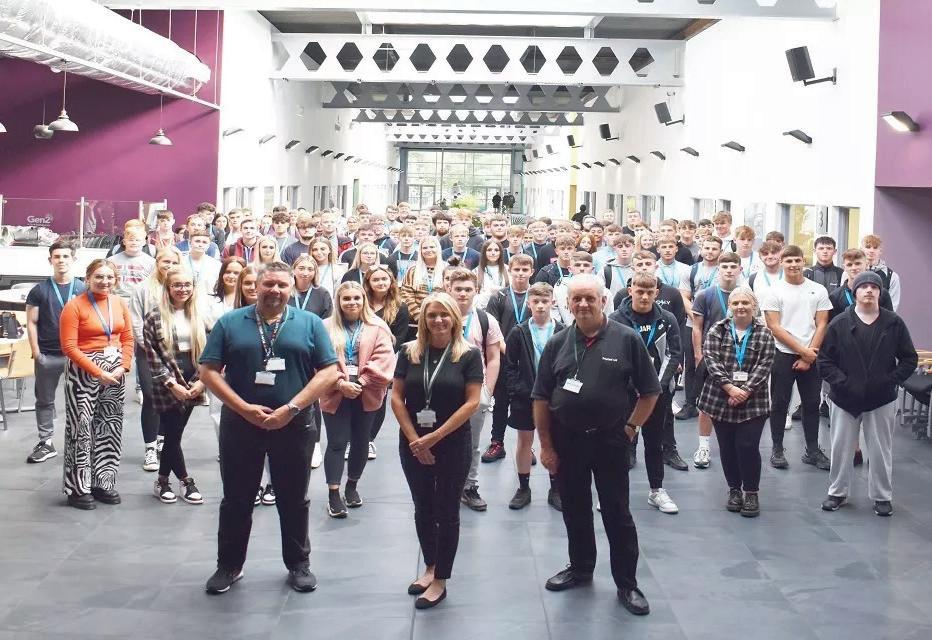
The latest intake means that the company has more than 600 apprentices currently completing their training with the company and our training provider, GEN2 in West Cumbria and Wigan and with Leigh in Risley.
Beyond the volume of recruits, we are particularly proud of the variety of training opportunities we are able to provide, with 18 different apprenticeship schemes. Our graduate scheme is also diverse with people starting their careers in science, engineering, technology, project management, business, and safety roles. Sellafield was recently voted in the top 100 apprentice employers in the country for 2022.
“I’d heard a lot about Sellafield Ltd from family and friends that work here. It excited me as it offers lots of opportunities for personal development, I chose the nuclear operator route as it sounded interesting and worthwhile. I wanted to be part of the biggest employer in the area and contribute towards its goal. I feel really privileged to be employed by Sellafield Ltd.”
Georgia Nevins, Nuclear Operator Apprentice Scheme
The apprentices will complete their training across multiple disciplines, from Level 2 (GCSE equivalent) to Level 6 (degree level) schemes. Those who have joined the graduate schemes will embark on a two-year programme designed to develop their behavioural, business, and technical skills.
“It is amazing to welcome 88 graduates—one of our biggest ever single intakes—from all corners of the country. The breadth and depth of knowledge and skill that they carry will undoubtedly bring innovation and creativity to help us achieve our purpose of creating a clean and safe environment for future generations.”
Marc Skillen, Graduate Development Manager, Sellafield
Ltd
As part of their formal welcome to Sellafield Ltd the graduates have already been involved in activities such as behavioural development, understanding what it means to be a nuclear professional, attending the Nuclear Vision Conference and working on a local community project.
2022 | WINTER — 29
NEW MEMBERS
BOCCARD UK LTD boccard.com
Boccard, a family owned business with over 100 years of heritage, is a major international player in the design and production of innovative industrial plants in the nuclear, industrial and life sciences markets.
Boccard offers a fully integrated digital delivery package across the entire EPC produc tion life cycle i.e. engineering, manufacturing, construction and maintenance.
BUILT ENVIRONMENT COMMUNICATIONS GROUP becg.com
BECG work on some of the UK’s biggest infrastructure and energy projects, for clients across the sector including nuclear new build, wind and solar, interconnectors and transmission, highways, and rail. With expertise in public affairs, planning communications, corporate public relations and marketing, we provide public and private sector clients with expert counsel and communications strategies.
DUAL FLUID ENERGY INC dual-fluid.com
Dual Fluid Energy (DFE) is developing Gen IV nuclear reactor technology based on its patented “dual fluid” principle. DFE is in the process of doing several test experiments to further develop the dual fluid principle in preparation for a building a prototype in the next five years. DFE is currently being supported by a number of private investors in Europe and North America.
GARDINER AND THEOBALD LLP gardiner.com
G&T is an independent construction and property consultancy working across all sectors of the built environment.
We focus on minimising risk and creating opportunities to maximise the value of our clients’ developments and property assets. We deliver Project Leadership, Commercial Success, Construction Excellence and Specialist Consultancy working.
NANO NUCLEAR ENERGY INC nanonuclearenergy.com
Nano Nuclear Energy Inc is a company of a world class nuclear technical team, comitted to building smaller, cheaper, and safer nuclear energy.
The company envisions readily replaceable mobile reactors which it can provide to customers, along with operative personnel, to power projects, residential and commercial enterprises, and major development projects.
PILLSBURY WINTHROP SHAW PITTMAN LLP pillsburylaw.com
Pillsbury Winthrop Shaw Pittman LLP is an international law firm with a particular focus on the technology and life sciences, energy, financial, and real estate and construction sectors. Pillsbury and its lawyers are highly regarded for their forward-thinking approach, their enthusiasm for collaborating across disciplines and their authoritative commercial awareness.
30 — WINTER | 2022
WELCOME TO OUR
COPENHAGEN ATOMICS copenhagenatomics.com
Copenhagen Atomics will develop, build, maintain, and decommission a fleet of autonomous reactors, eventually numbering in the thousands.
At Copenhagen Atomics you will find people with real skills. Building and solving engineering challenges with our own hands.
Not a member? To find out about the NIA and benefits of membership scan the QR code. To discuss membership options available to your company call +44 (0)20 7766 6651 or email membership@niauk.org
CRAYSIDE CONSULTING craysideconsulting.co.uk
Crayside Consulting is an innovative, forward-thinking multi-disciplinary design & survey consultancy delivering projects in critical infrastructure sectors. We are committed to helping provide you with high-quality solutions for your projects including MEP, Civils & Structural, BIM, Earthing & Lightning Protection and in-depth surveying.
ICR Integrity Ltd icr-world.com
ICR is a global provider of specialist maintenance, integrity and inspection solutions for the oil and gas, power, defence, nuclear, utilities and renewa bles industries. As experts in pipeline and structural maintenance, integrity, corrosion and repair solutions, we offer an integrated and efficient approach to asset integrity management.
MACE macegroup.com
Mace is a global expert in shaping the built environment—helping to lead the way to a more connected, resilient and sustainable world.
We empower and encourage each other, our clients and everyone we work with to embrace challenge and look beyond the boundaries of today.
PRIESTLAND CONSULTING LTD priestland.com
Priestland Consulting is an independent, specialist consultancy that champions construction technology for the benefit of asset owners, contractors, consultants and con struction technology start-ups.
We support blue chip utilities, con sultancies and contractors in the use of data, digital engineering software.










THERMAL ENGINEERING INTERNATIONAL babcockpower.com/nuclear
TEi is a leading global supplier of new and replacement heat transfer equipment to the global nuclear power industry. With installations spanning 15 countries around the world, TEi offers solutions that merge cutting edge technology with world-class service. We partner in all aspects of heat transfer equipment to keep nuclear power plants running at their highest capacity.
2022 | WINTER — 31
Clean Energy Action Forum
This September, the NIA headed to the first Global Clean Energy Action Forum—a joint convening of the 13th Clean Energy Ministerial and the 7th Mission Innovation ministerial—held in Pittsburgh, US. Famous faces included Bill Gates and US Special Presidential Envoy for Climate, John Kerry, who attended alongside Government, industry, and academia at this three-day event.
Nuclear power was one of the technologies highlighted by the US hosts, partly due to the importance of nuclear power to the city of Pittsburgh and Pennsylvania, which has the second highest concentration of nuclear power stations in any US state. Pennsylvania is also the birthplace and home of Westinghouse Electric Company, which now operates across the international nuclear sector.
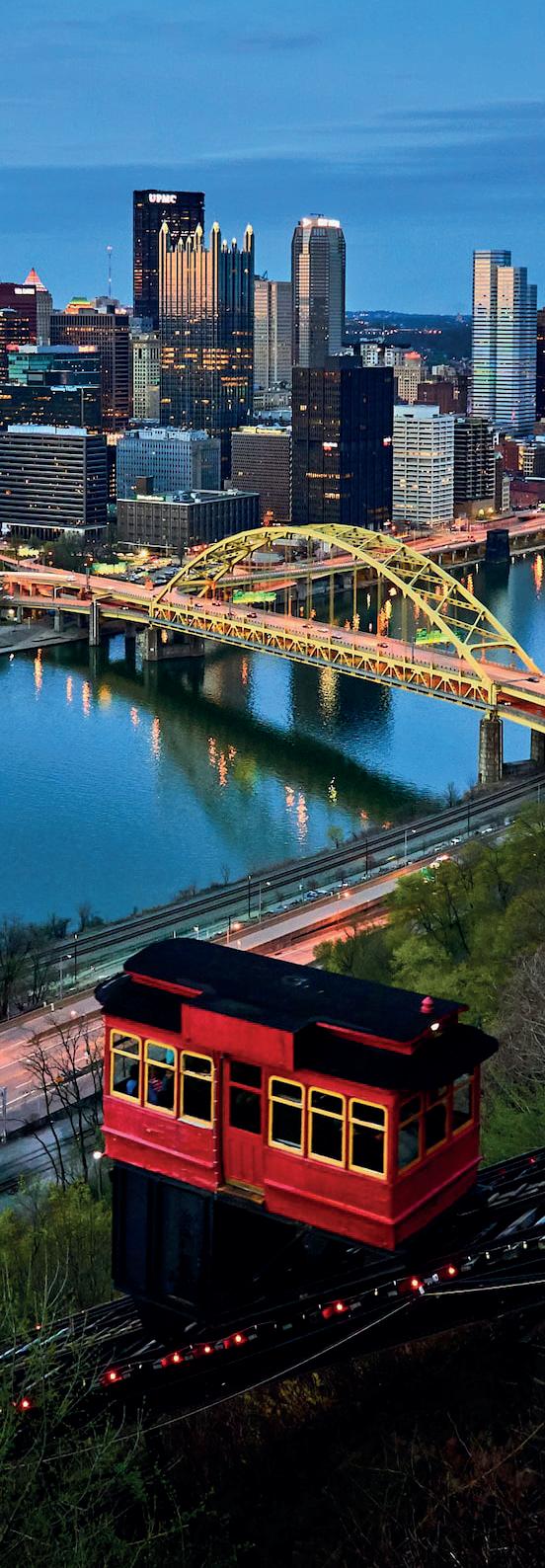
The US has a rich nuclear history, being the first to generate a usable amount of electricity from nuclear fission and today having the largest number of nuclear power plants in the world. The US and the UK have many parallels in its history, most recently in our shared ambition of a nuclear renaissance in our respective countries.
The US and UK were among the first adopters of nuclear as a low-carbon energy source, alongside other Western countries like Canada. “We saw a huge change in smog days because of nuclear. As we phased out coal, you can actually see the skyline and breathe outside during the summer,” said Mike Rencheck, COO at Canadian operator Bruce Power, at one of the three panels hosted by the NIA in partnership with our US sister organisation, the Nuclear Energy Institute.
Our countries remain great collaborators today, as highlighted in these sessions, particularly on the harmonisation of standards and shared goals for the deployment of SMRs worldwide. An agreement on cooperation between Governments for a new nuclear power station at Wylfa, Anglesey, is also in the works.
The conference and subsequent agreements with the US show that the UK remains an attractive proposition for many other countries to invest in and to collaborate with. Since the release of the British Energy Security Strategy following the invasion of Ukraine, where former Prime Minister Boris Johnson committed to eight nuclear reactors by 2030 and 24GW of new nuclear by 2050, interest in the UK as a place to invest has never been more evident.
But our policies do not match our ambitions. The US Government used the Global Clean Energy Action Forum to announce how the use of tax credits in its Inflation Reduction Act (IRA), which will provide investment in domestic energy policies, will be used to deploy SMRs to combat climate change. This was a landmark piece of legislation for the country.
Many here started to ask questions about what the UK is doing and where were our headline policies to support new nuclear development. We don’t have answers to these questions yet, with many putting faith in the establishment of Great British Nuclear to capitalise on the current interest in the UK market.
However, despite recommendations being submitted to Number 10 in September, we are still waiting for a formal announcement on GBN. While the US remain allies, their recent actions and commitment to investing in new nuclear power should be a reminder to us to move quickly and effectively to remain competitive. I look forward to seeing how the new Prime Minister tackles this challenge in his first few months.
GEORGINA HINES • POLICY ANALYST • NIA
▲ Photo by Vidar Nordli-Mathisen on Unsplash — https://unsplash.com/photos/9HGqJq3vglc
Hello, it’s me again doing the PowerPolitics column, filling in for Lincoln while he’s on parental leave. Since it was first highlighted to me a few months ago that I would be covering for him we’ve gone through three Prime Ministers, Chancellors, and Energy Secretaries; as well as having a new Monarch. It’s tough times to be a government spin doctor… or a political satirist.
Never has the term “at the time of writing” been such a heavy caveat for anything I’ve written.
So… at the time of writing, it’s not even been three whole weeks since Kwasi Kwarteng was summoned back from America to be sacked by Liz Truss, reminding us politicos of the good old days when it was a little bit funny to track Priti Patel’s flight from Uganda before being sacked from Theresa May’s Cabinet.
The entertainment of Kwarteng being the last person in the country to know he was getting the boot was only matched when I found out that Anne Widdicombe lasted longer on the BBC’s Strictly Come Dancing than either he or Truss did in Downing Street.
The first time I wrote this column was in our Winter 2019 edition during the General Election. I remarked about how politics never ceases to surprise me; “I regularly marvel at how perceptions can change instantaneously, and how slates can so easily be wiped clean in the eyes of the beholder.”

My amazement is alive and well. Despite the Conservatives having been in power for more than 12 years, in the past few months they’ve regenerated twice, and are confidently blaming previous iterations of themselves for past mistakes without any sense of irony or contradiction. Whether it’s about energy security, immigration, or improving the rail network, it’s genuinely impressive how every reprise believes it can deliver change.
However in the real world, the rest of us are now having to live the aftermath of what happens when you try enacting a libertarian thought experiment that nobody voted for as official fiscal policy, at a time when monetary policy was already going in the opposite direction.
For many, the reality has hit almost straight away, with mortgage repayments increasing by
thousands of pounds a year, U-turns on tax cuts, and a potentially tough winter ahead on energy bills, despite the unit price cap. The new Chancellor has already indicated there will be massive spending cuts across all Whitehall departments, and even tax rises. How extreme, and whose budgets are getting slashed were laid out at the Autumn Statement, with the nation primed for yet more uncomfortable news.
One of the biggest casualties, when daily government business is putting out fires of its own making, is always long-term strategy and planning.
The energy crisis hasn’t gone away, and the measures being taken today to address it must be met with equal, if not greater, action in preventing this from ever happening again. However, to date, the UK is no more insulated from volatile international energy markets than it was 18 months ago, nor have we made any gains towards our 2050 Net Zero goal.
Political turmoil has delayed decisions on almost everything, including the establishment of Great British Nuclear, the Treasury’s definition of what can be deemed a sustainable investment, and announcements on several nationally critical infrastructure projects.
Justifying spending large amounts of taxpayers’ money on projects which won’t come into fruition for decades isn’t the easiest job in the world, but it’s a crucial part of being in government, if it was easy, anybody would do it. It’s much better to face these kinds of things with a sense of poise and rationality, otherwise we are all committed to being unwilling members of the “anti-growth coalition”.
If the Sunak administration can oversee a period of stability, then we might get some progress on the critical decisions such as Sizewell C, Great British Nuclear and hopefully some positive news for Wylfa. Yet, at the time of writing, after less than two weeks back in office the not-so-new Home Secretary is already on very shaky ground. It’s anybody’s guess how long the peace will last.
Oh, and just when you think things can’t get any stranger, Matt Hancock has just announced he’s going on I’m a Celebrity… At least he now knows to look out for hidden cameras.
2022 | WINTER — 33 IEUAN MÔN WILLIAMS • HEAD OF POLICY & PUBLIC AFFAIRS • NIA
The energy crisis hasn’t gone away, and the measures being taken today to address it must be met with equal, if not greater, action in preventing this from ever happening again.
Coming up at Nuclear Week
Monday 30 January
Nuclear Decommissioning Authority: The Role of Decommissioning in the UK’s Energy Future 18:00-19:00
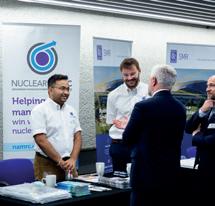
Hosted by Mark Jenkinson MP in the Thames Pavilion RSVP to: lucy.austin@nda.gov.uk
Nuclear Week in Parliament: Welcome Reception 19:00-22:00
Hosted by Virginia Crosbie MP in the Churchill Room RSVP to: jon.woodburn@niauk.org
Tuesday 31 January
Urenco Panel Event: Generation Climate –Embracing the Voices of Youth in Nuclear 09:00-11:00
Hosted by Virginia Crosbie MP in the Attlee Suite of Portcullis House RSVP to: joseph.priestley@urenco.com

Rolls-Royce SMR: Ask an Engineer 11:00-12:30
Hosted by John Stevenson MP in Portcullis House RSVP to: ross.reid@rolls-royce-smr.com
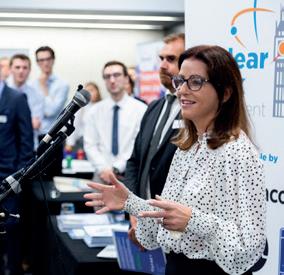

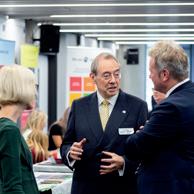
Nuclear Week in Parliament: Skills and Apprenticeships Fair 12:30-16:00
Hosted by Charlotte Nichols MP in the Attlee Suite of Portcullis House RSVP to: jon.woodburn@niauk.org
Nuclear Skills Academy in Parliament by Nuclear AMRC 15:30 to 17:00
Hosted by Lord Ravensdale in the Cholmondeley Room and Terrace RSVP to: jo.byron@namrc.co.uk
Westinghouse: The global role of the UK’s nuclear industry 17:00-18:30
Hosted by Lord Ravensdale in the Home Room of the House of Lords RSVP to: rory.oneill@westinghouse.com
Wednesday 1 February
National Nuclear Laboratory: Nuclear Science to Benefit Society 08:30-09:45
Hosted by Virginia Crosbie MP in the Thames Pavilion RSVP to: engagement@uknnl.com
NUVIA: Fission and Fusion – Friends or Foes? 10:30-12:30
Hosted by David Johnston OBE, MP in Room C, 1 Parliament Street RSVP to: louise.welsh@nuvia.com
Nuclear Week in Parliament: British Nuclear Showcase Reception 12:45-15:30

Hosted by Lord McNicol of West Kilbride in the Cholmondeley Room and Terrace RSVP to: jon.woodburn@niauk.org
A nuclear renaissance in the UK: Exploring the vital role of Franco-British collaboration 16:00-17:45
Hosted by Virginia Crosbie MP in Terrace Dining Room A RSVP to: jdobson-smith@assystem.com
Women in Nuclear UK: Annual Dinner 19:00-22:00
Ernst & Young, 1 More London Place RSVP to: lucy.austin@nda.gov.uk




























































